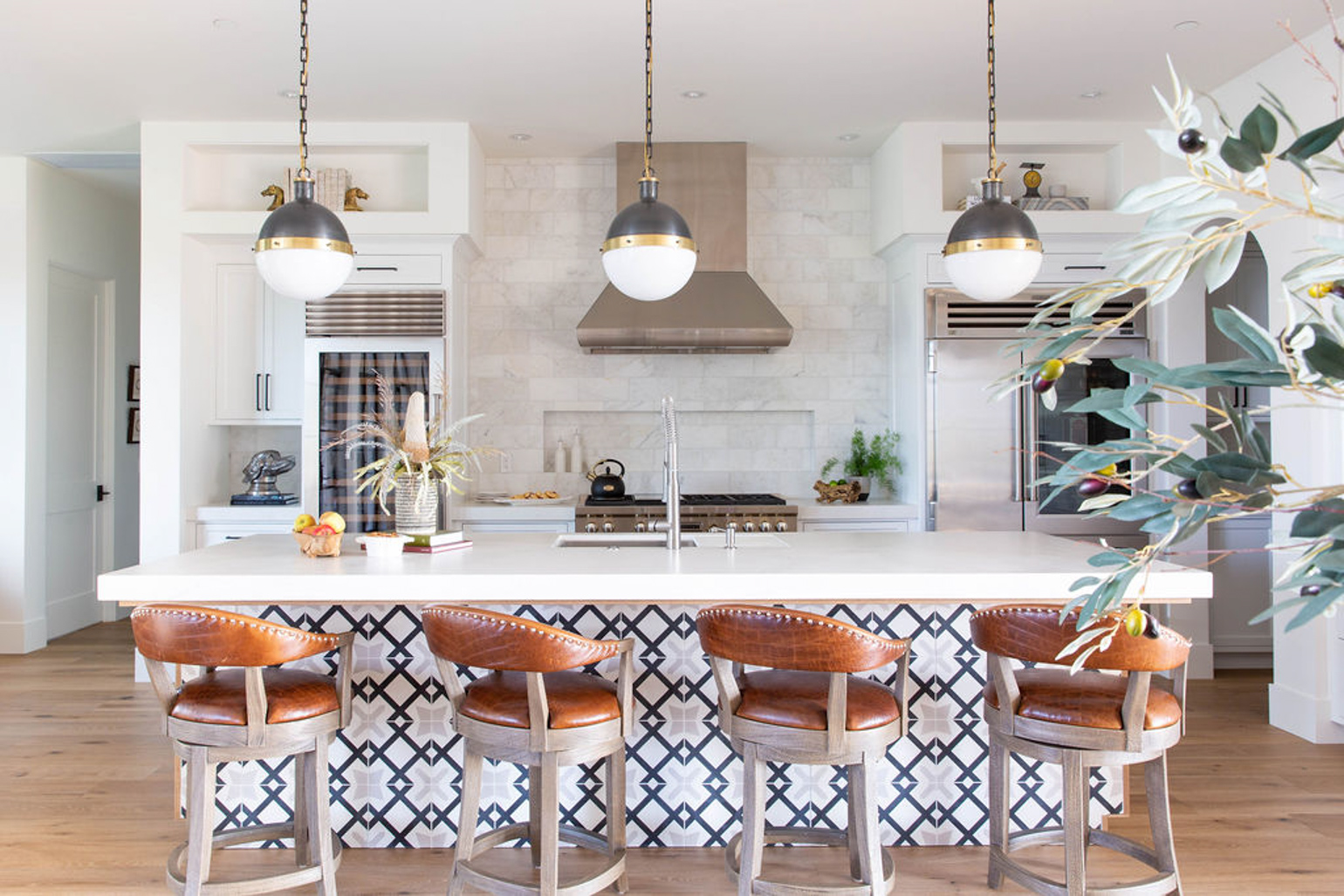The right lighting can transform a kitchen to a warm, inviting centerpiece of your home. In 2025, kitchen lighting design is about more than just a simple overhead fixture; it's a blend of style, technology, and practicality. This year's trends focus on layered ambient, task, and accent lighting, incorporating stunning statement pendants, warm brass finishes, and smart LED innovations. Ready to give your kitchen a glow-up? Explore 42 of the best kitchen lighting ideas of 2025 to inspire your kitchen design.
Lighting not only serves a functional aspect of any design but it also influences the atmosphere and mood of a space.

Kitchen Ceiling Lights
1. Flush Mount Ceiling Lights
-1758265491.jpg) Image: Arsight Studio
Image: Arsight Studio
These fixtures sit directly against the surface, making them a good choice for kitchens with lower ceilings. They provide even, general lighting without taking up visual space.
Pros: Can add subtle texture or pattern to the ceiling.
Cons: Slightly reduces vertical space in small kitchens.
Best Use Case: Ideal for low ceilings or minimalist kitchens.
2. Semi-Flush Mount Ceiling Lights
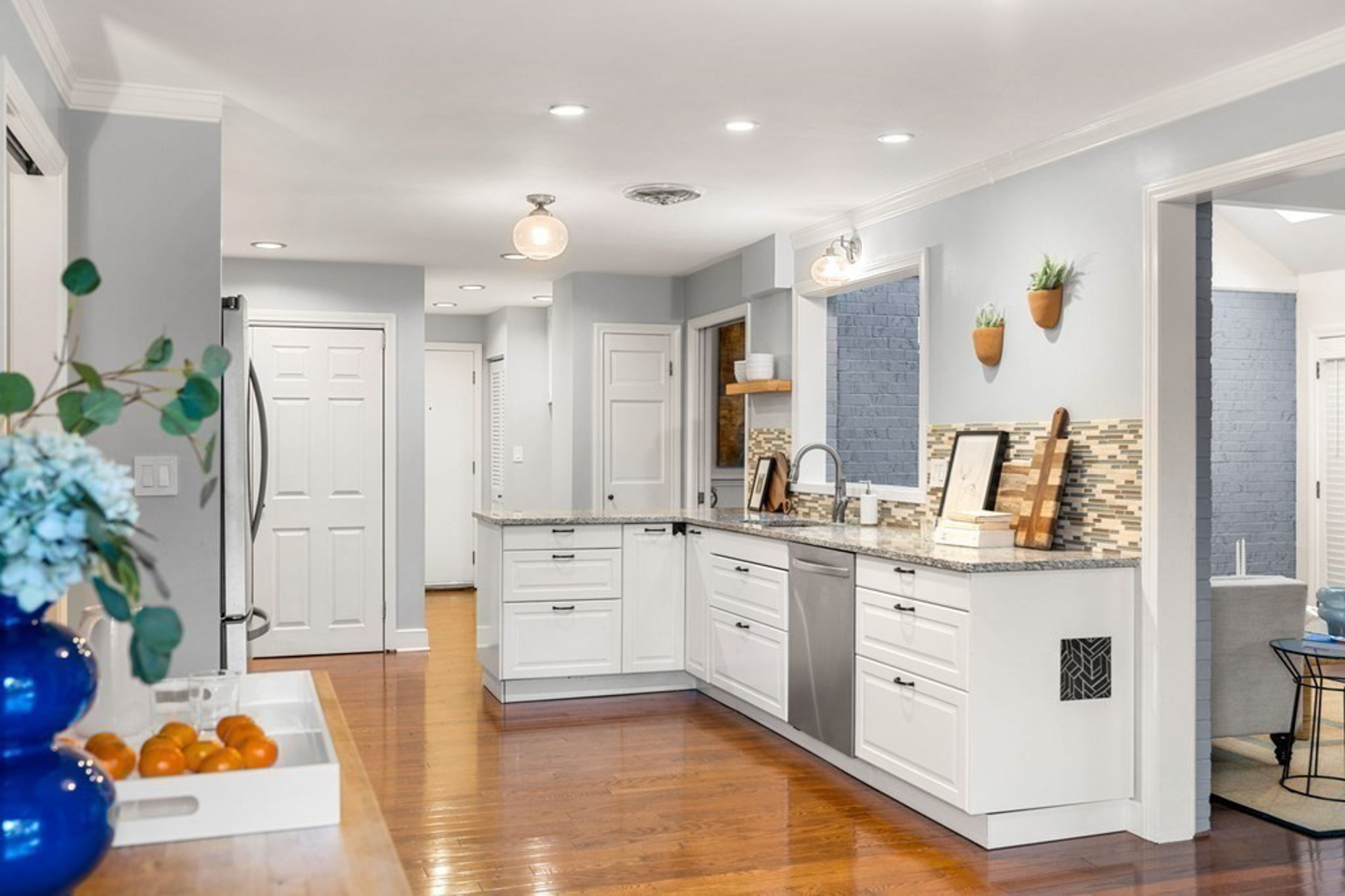 Image: JessFinessed
Image: JessFinessed
Unlike flush mounts, these hang a few inches below the ceiling, often with decorative detailing.
Pros: Adds style and dimension, works in standard-height ceilings.
Cons: Slightly more expensive than flush mounts, may interfere with tall cabinets in some layouts.
Best Use Case: Perfect for kitchens with standard-height ceilings that need a decorative touch.
3. Monopoint Ceiling Lights
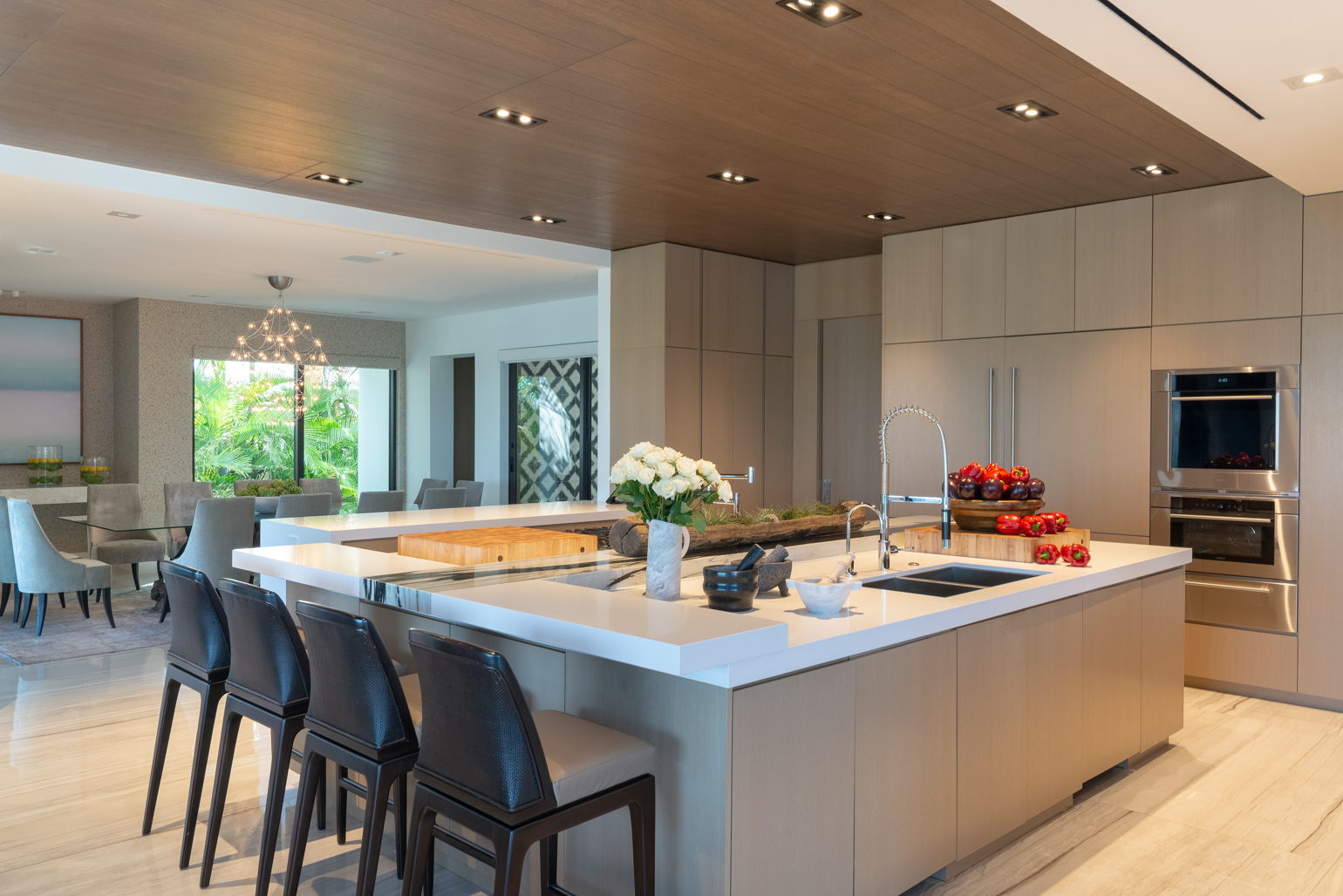 Image: DiMare Design
Image: DiMare Design
Monopoint lights are single light fixtures mounted to the ceiling, often adjustable for task lighting. They work well when you need focused illumination in specific kitchen zones.
Pros: Can be used to highlight artwork or architectural features.
Cons: May cast shadows if positioned incorrectly.
Best Use Case: Best for focused task lighting or accenting a specific zone.
4. LED Ceiling Lights
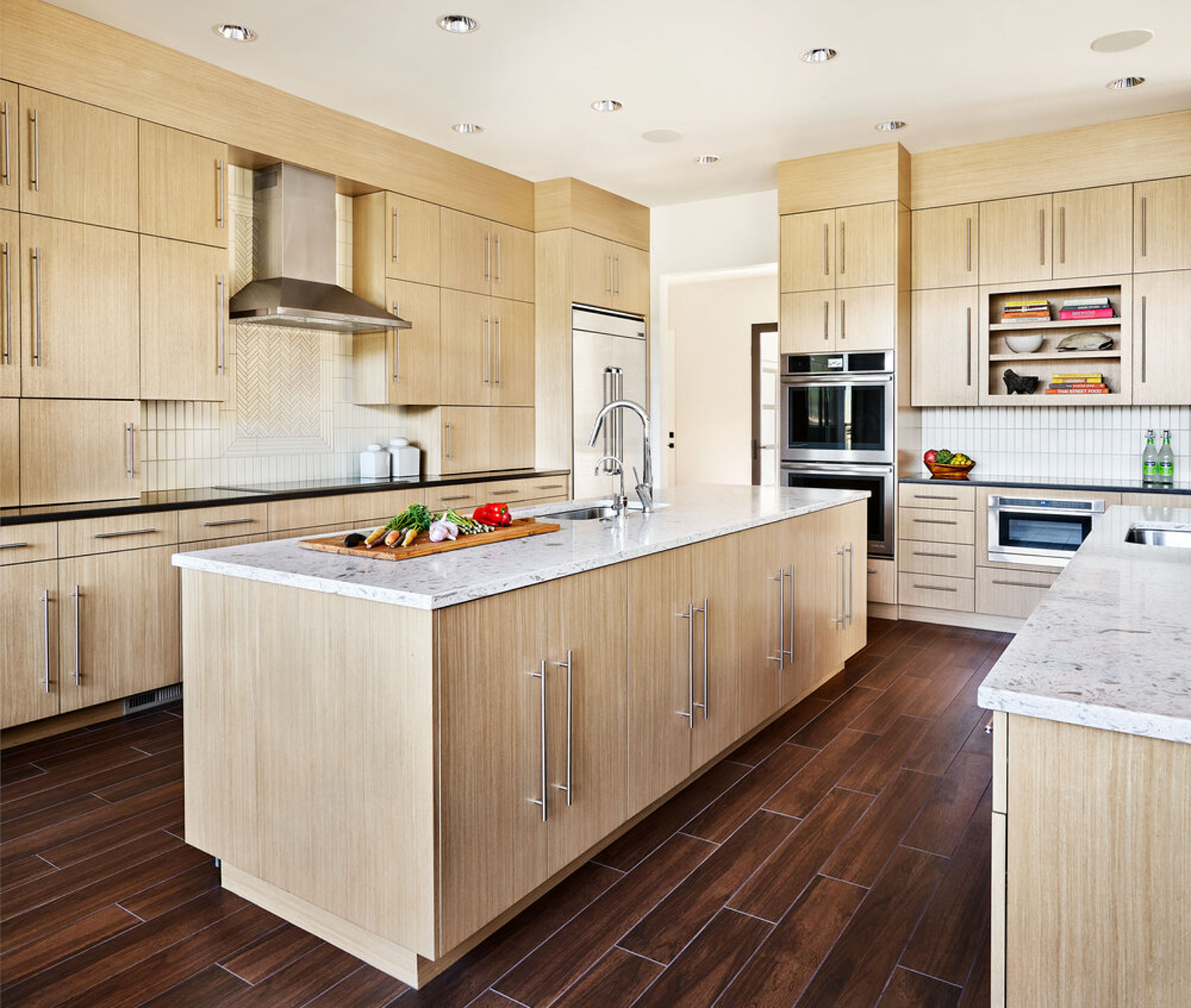 Image: Studio Garrison
Image: Studio Garrison
These are fixtures designed with integrated LED technology, offering energy efficiency and long lifespan. They come in many forms, from flush mounts to recessed panels.
Pros: Can offer color temperature options for mood lighting.
Cons: Some cheap models flicker or have uneven brightness.
Best Use Case: Energy-conscious kitchens needing long-lasting, versatile lighting.
5. Skylight Integration / Solar Tubes
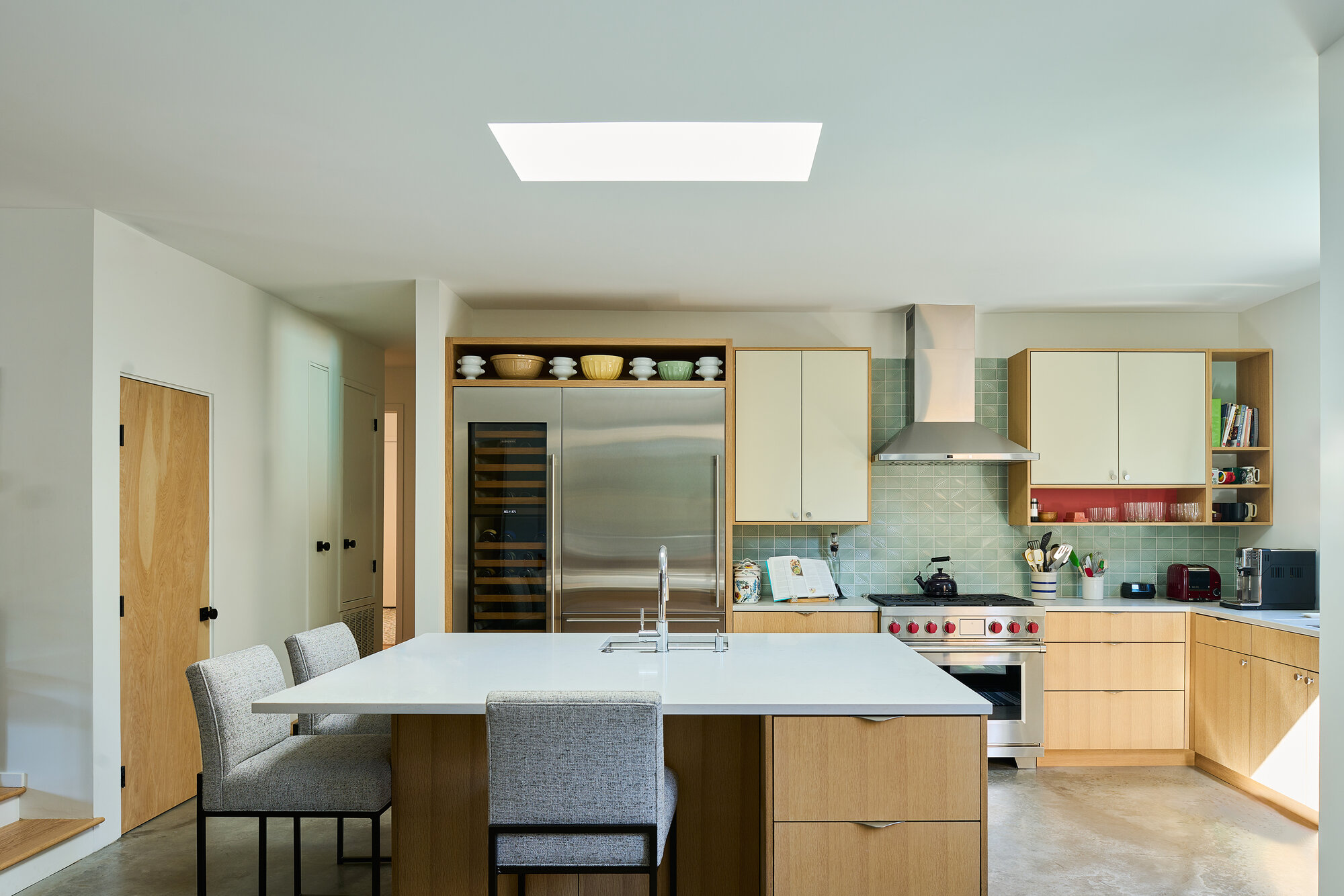 Image: DESIGN DRAW BUILD
Image: DESIGN DRAW BUILD
“Natural light is always the best, so I recommend prioritizing that,” says Rick Berres, Owner of Honey-Doers. “If you don’t have enough kitchen windows, build one! Add a skylight, if it’s possible, that’s a fantastic way to add gorgeous lighting to your space, but without sacrificing wallspace.” Skylights and solar tubes bring natural light into the kitchen from above, reducing reliance on artificial lighting.
Pros: Enhances natural ventilation if operable.
Cons: It’s not a cheap addition. Skylight costs $1,080 to $1,966 to install.
Best Use Case: Great for kitchens with limited windows or for maximizing daylight.
6. Track Ceiling Lights
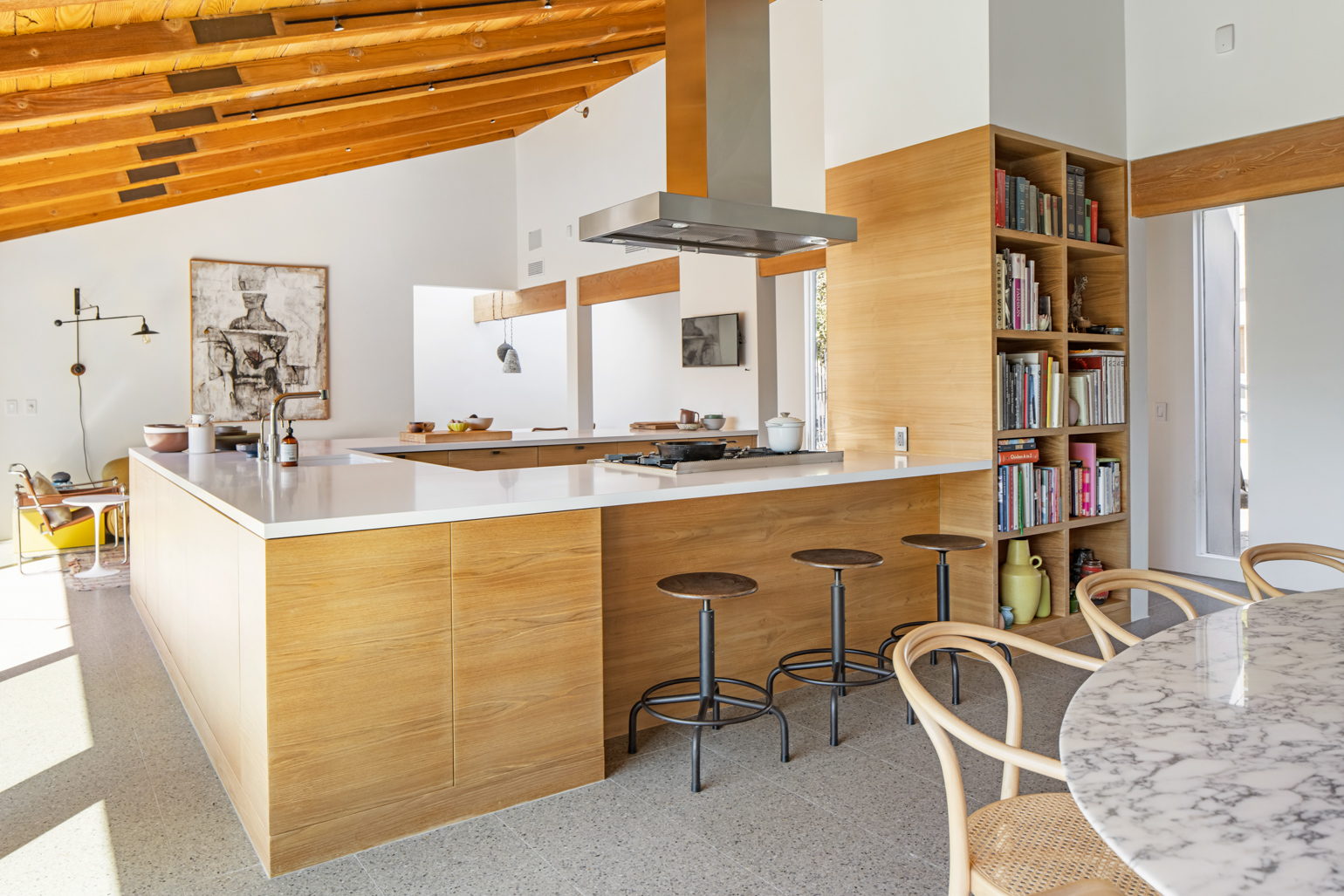 Image: Letter Four, Inc.
Image: Letter Four, Inc.
Track ceiling lights are a type of lighting system where multiple light fixtures are mounted on a single track attached to the ceiling. Each individual light can usually be adjusted or repositioned along the track, allowing you to direct light exactly where it’s needed.
Pros: Easy to add or reposition individual lights without major rewiring.
Cons: Tracks may require regular cleaning due to dust accumulation.
Best Use Case: Ideal for open kitchens or spaces that need flexible lighting arrangements.
7. Statement Lighting
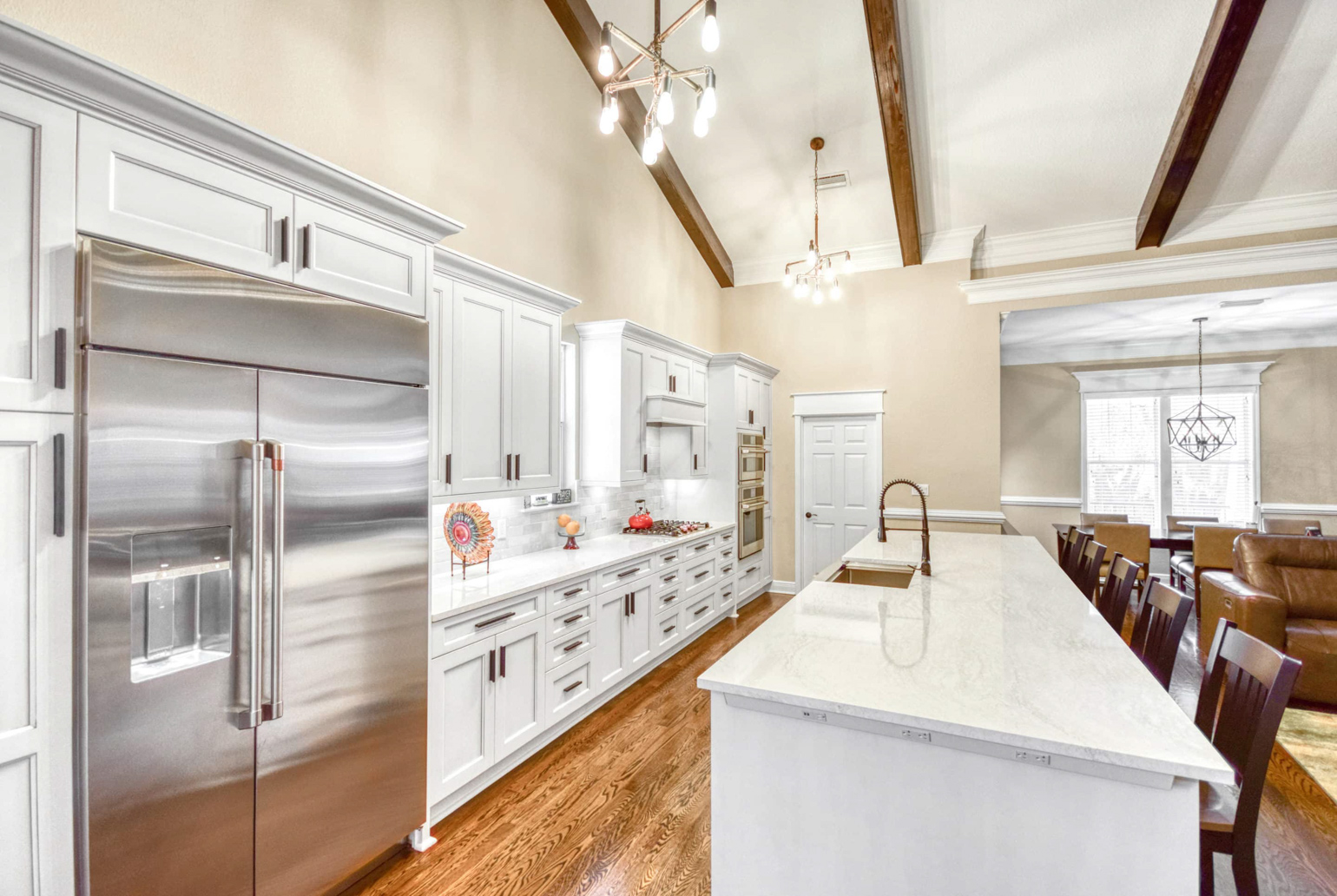 Image: McManus Kitchen and Bath
Image: McManus Kitchen and Bath
Statement lighting makes a bold impression, turning a fixture into a key design element in your kitchen.
Pros: Acts as a centerpiece that defines the kitchen’s style and adds personality.
Cons: Can dominate the room if not scaled properly, may limit flexibility in other décor choices, and often comes with a higher price tag than standard fixtures.
Best Use Case: Best for kitchens where you want a bold, decorative focal point.
8. Recessed Lighting
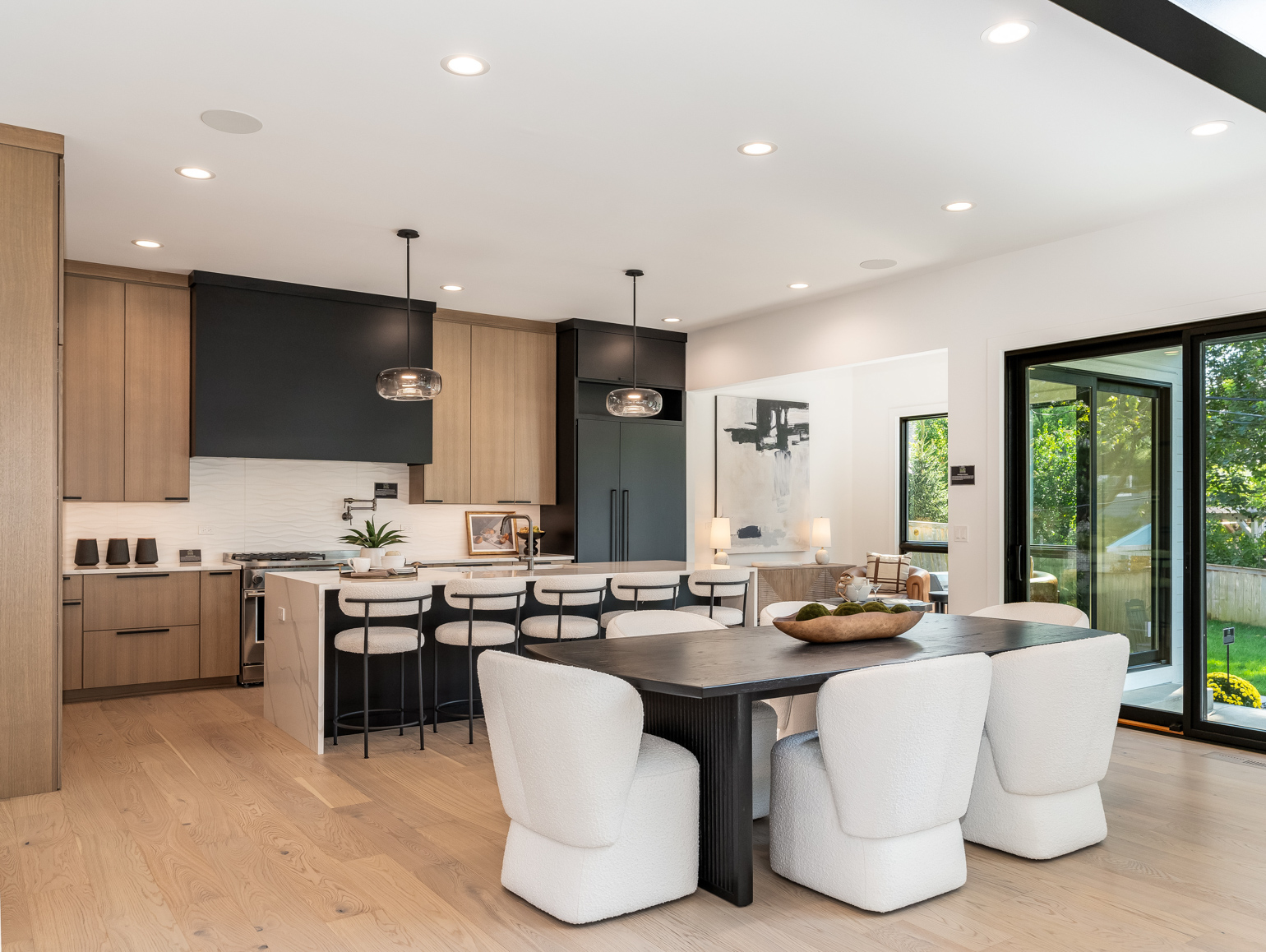 Image: Chicagoland Home Staging
Image: Chicagoland Home Staging
“Recessed ceiling fixtures are evenly spaced to brighten the space without overwhelming the overall design,” explains Danny Niemela, Co-owner, Vice President and CFO at ArDan Construction. When paired with dimmers or adjustable trims, they can shift from focused task lighting to a softer glow for entertaining.
Pros: They’re a sleek option for kitchens with low ceilings.
Cons: The recessed lights price range from $176 to $328 per fixture, which is more expensive than standard ceiling lights.
Best Use Case: Perfect modern kitchen lighting.
Under Cabinet Lighting
9. LED Strips
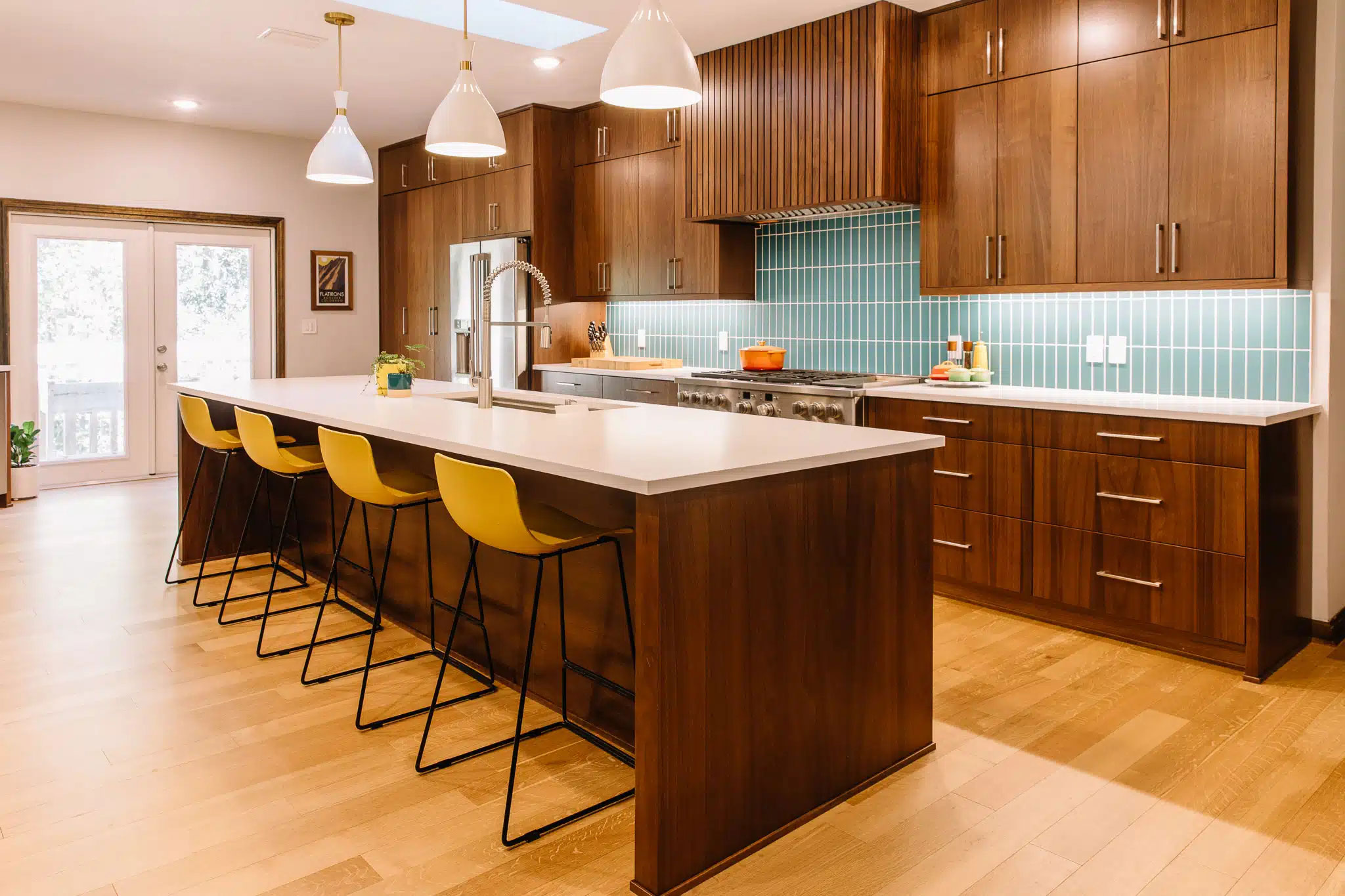 Image: McManus Kitchen and Bath
Image: McManus Kitchen and Bath
Undercabinet LED strips are slim, flexible lighting fixtures installed beneath kitchen cabinets. They provide focused illumination directly onto countertops, making meal prep and other tasks easier while adding a modern, sleek look to your kitchen.
Pros: Can be cut to size for custom lengths.
Cons: Exposed edges may show if not properly installed or covered.
Best Use Case: Ideal for task lighting over prep areas.
10. Recessed Can Lighting
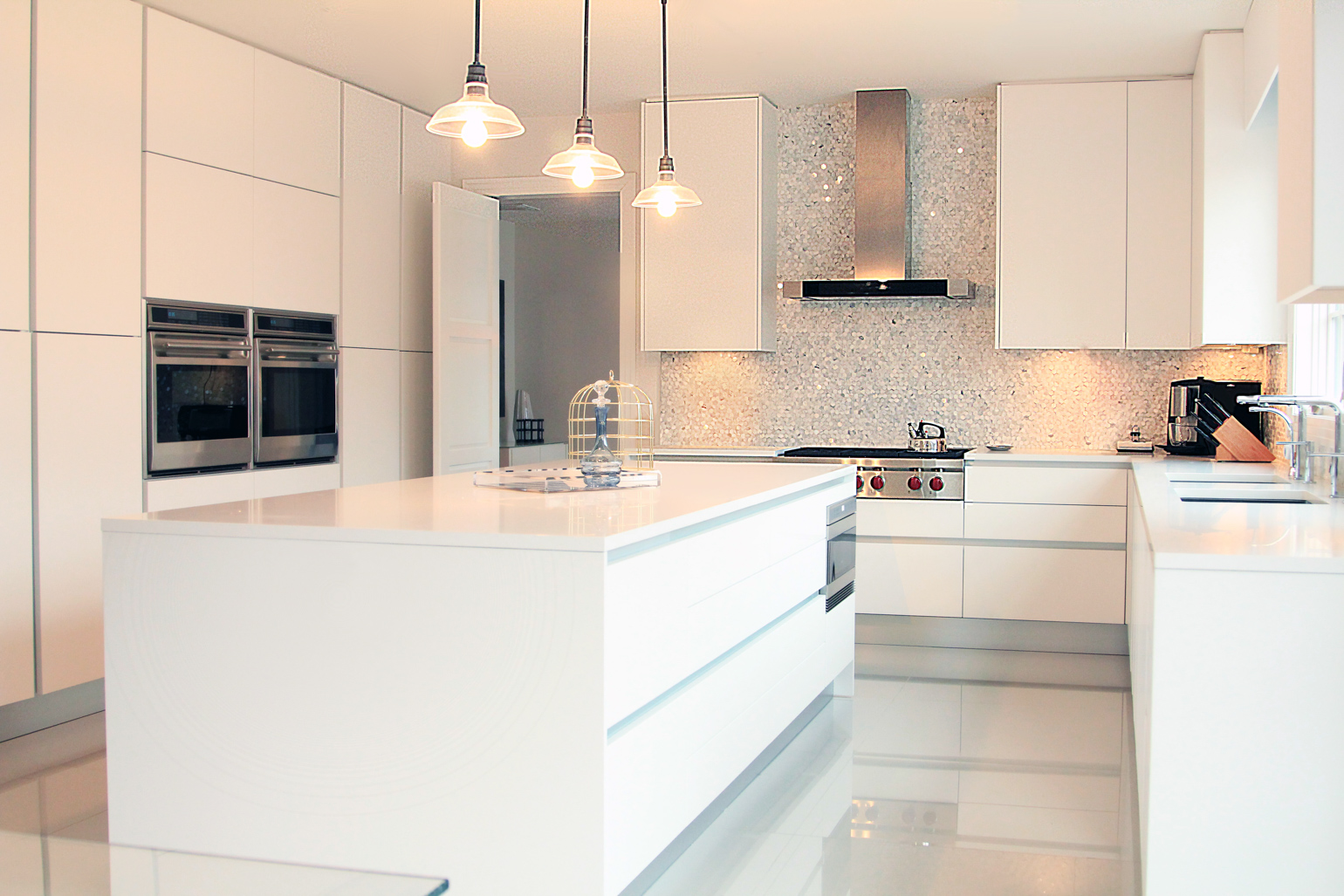 Image: DiMare Design
Image: DiMare Design
Small recessed cans can be installed under cabinets to deliver direct task lighting on countertops. They’re a discreet option but usually require professional installation.
Pros: Minimal glare when positioned correctly.
Cons: Hard to retrofit into older cabinetry without modifications.
Best Use Case: Great for modern kitchens needing flexible, even lighting under cabinets.
11. Tube Lighting
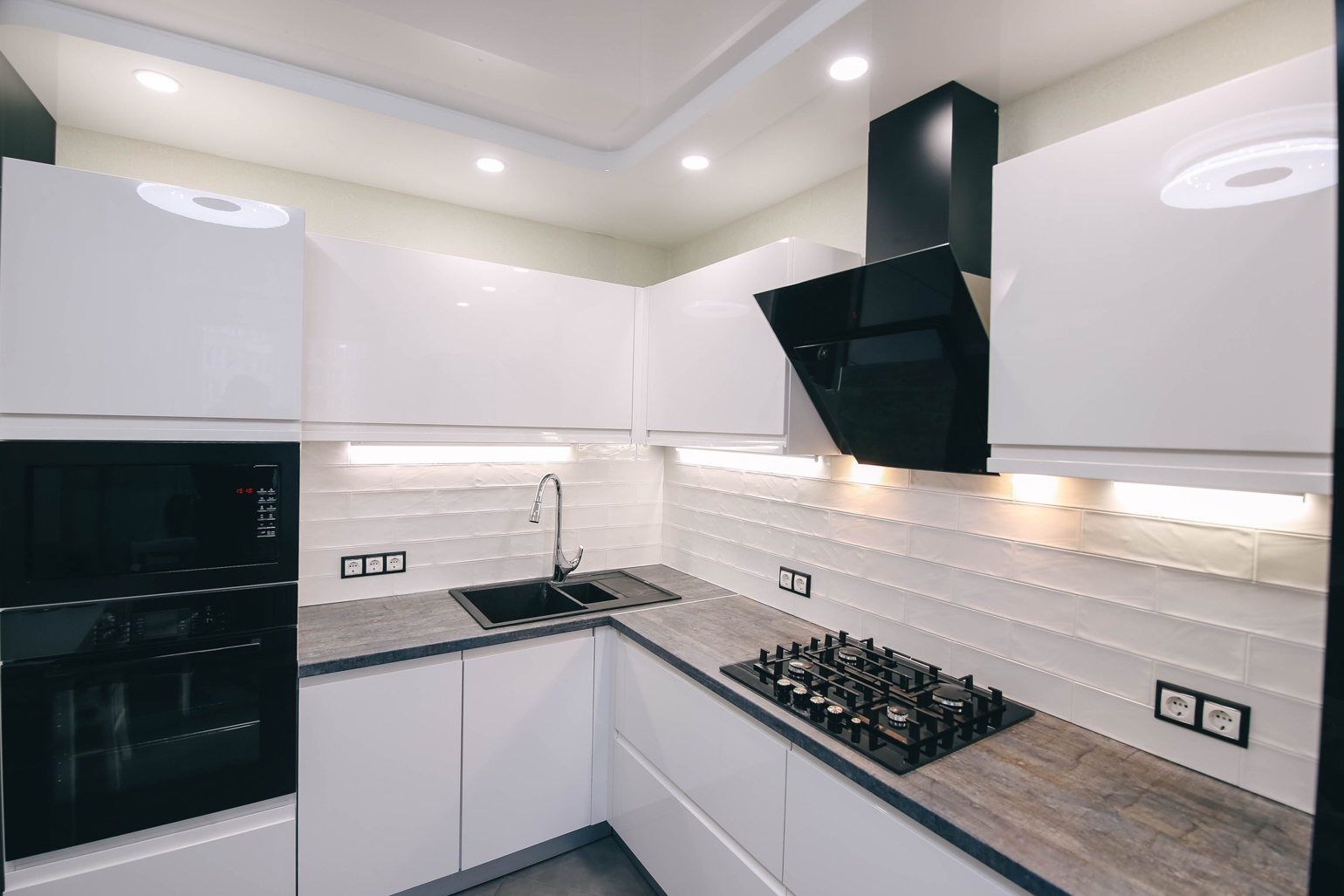 These fixtures resemble mini fluorescent or LED tubes and provide bright, continuous illumination. They’re a classic, budget-friendly choice that works especially well in traditional kitchens.
These fixtures resemble mini fluorescent or LED tubes and provide bright, continuous illumination. They’re a classic, budget-friendly choice that works especially well in traditional kitchens.
Pros: Provides consistent light over long runs.
Cons: Bulb replacements may be less energy-efficient than newer LEDs.
Best Use Case: Budget-friendly option for traditional or large kitchens.
12. Tape Lighting
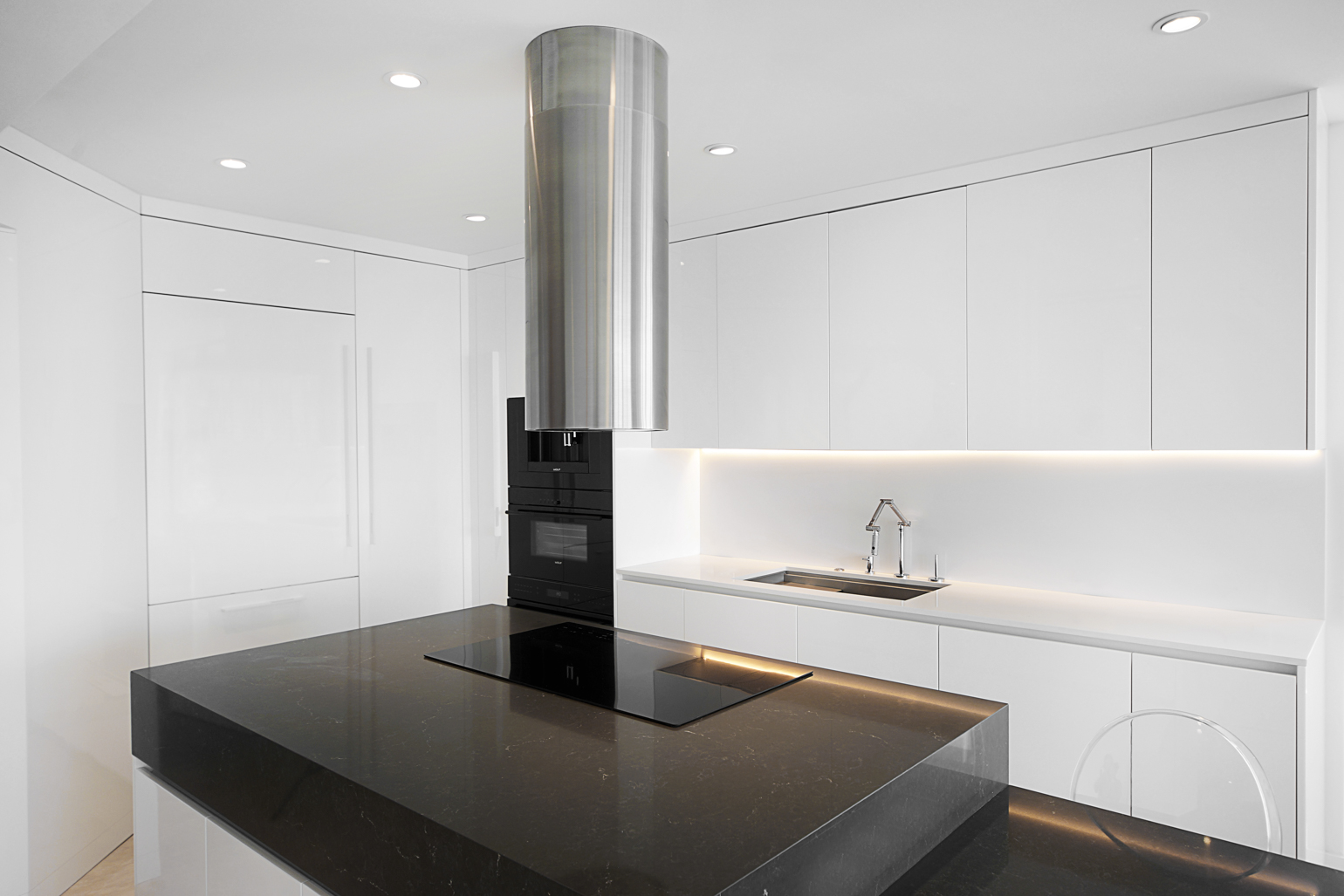 Image: DiMare Design
Image: DiMare Design
Tape lighting is similar to LED strips but thinner and more flexible, making it easy to tuck into tight spaces. It’s often used for subtle accent lighting rather than a bright task light.
Pros: Ultra-thin and flexible; works well for layering.
Cons: Not bright enough for heavy task lighting; adhesive may fail in humid environments.
Best Use Case: Excellent for subtle accent lighting or ambiance.
13. Puck Lights
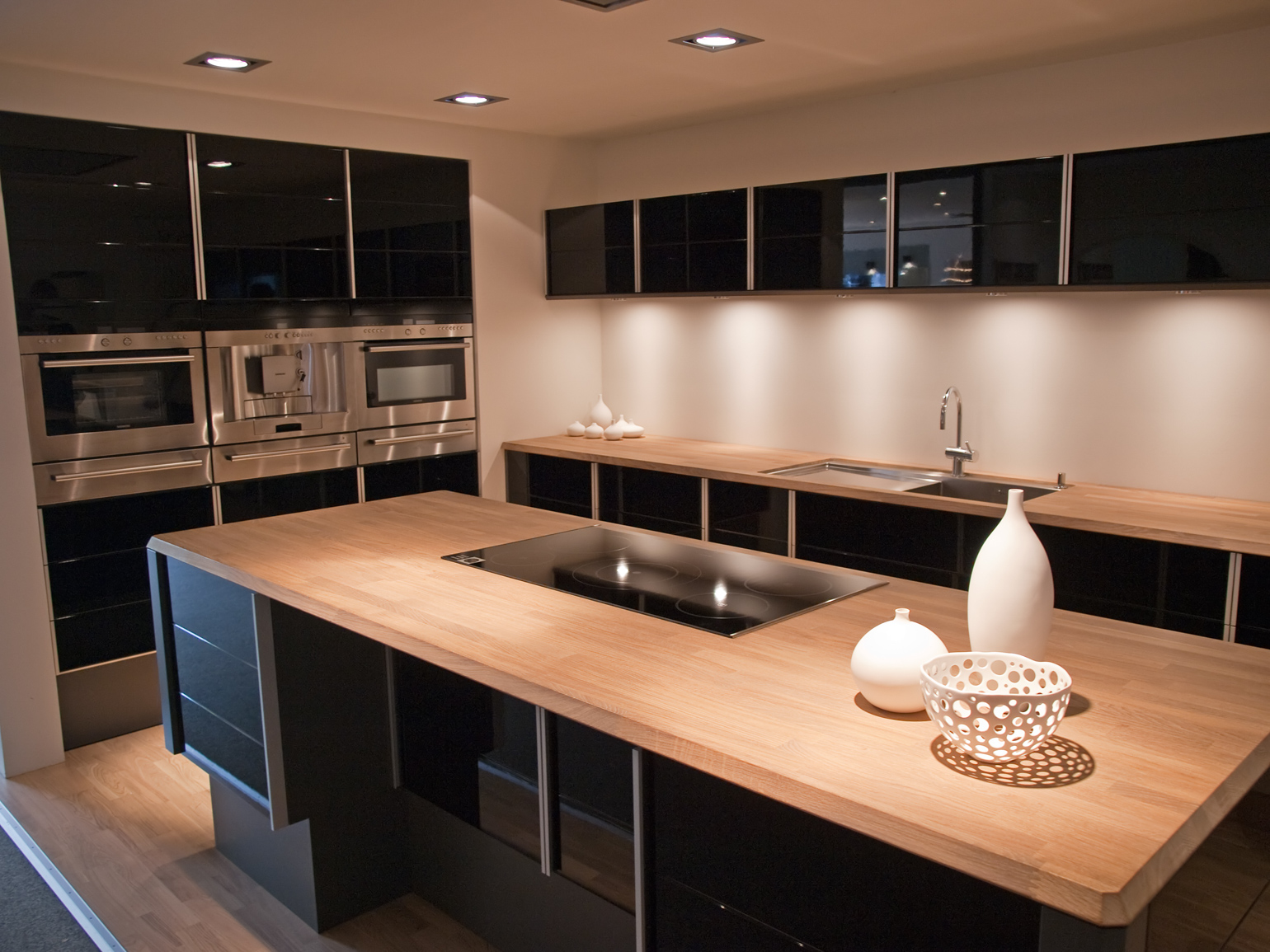 Round, hockey-puck-shaped lights can be installed individually or in series under cabinets. They provide focused pools of light, perfect for highlighting specific areas like a cutting board or coffee station.
Round, hockey-puck-shaped lights can be installed individually or in series under cabinets. They provide focused pools of light, perfect for highlighting specific areas like a cutting board or coffee station.
Pros: Adds sculptural or decorative effect; focused light for work zones.
Cons: Creates pools of light rather than even coverage.
Best Use Case: Best for highlighting specific areas like a coffee station or cutting board.
14. Light Bars
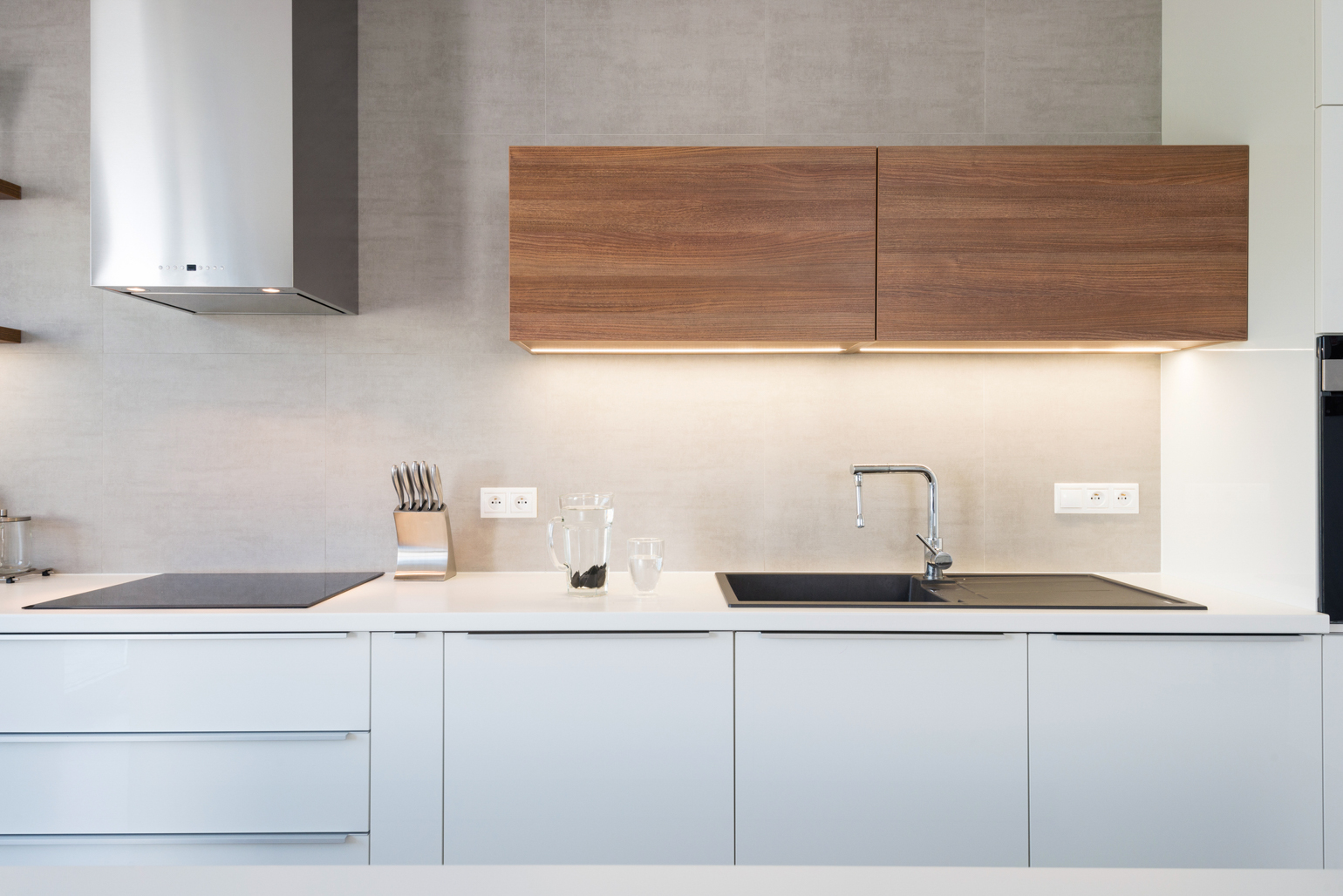 Light bars are slim, rigid fixtures that mount under cabinets to provide bright, even illumination. Many come in plug-and-play kits, making them a simple DIY option for homeowners.
Light bars are slim, rigid fixtures that mount under cabinets to provide bright, even illumination. Many come in plug-and-play kits, making them a simple DIY option for homeowners.
Pros: Easy DIY installation with uniform illumination.
Cons: Limited flexibility in length or placement; may need a compatible driver for dimming.
Best Use Case: Ideal for homeowners seeking ready-to-install undercabinet lighting.
15. Under-Shelf Lighting
.jpg) This refers to any type of lighting mounted beneath open shelving rather than cabinets. It’s often used for accent lighting to showcase décor, glassware, or cookbooks.
This refers to any type of lighting mounted beneath open shelving rather than cabinets. It’s often used for accent lighting to showcase décor, glassware, or cookbooks.
Pros: Highlights décor and glassware beautifully.
Cons: May not be bright enough for food prep without additional lighting.
Best Use Case: Perfect for open shelving, accenting decorative displays, or creating ambiance.
Kitchen Island Lighting
16. Lower Hanging Pendant Light
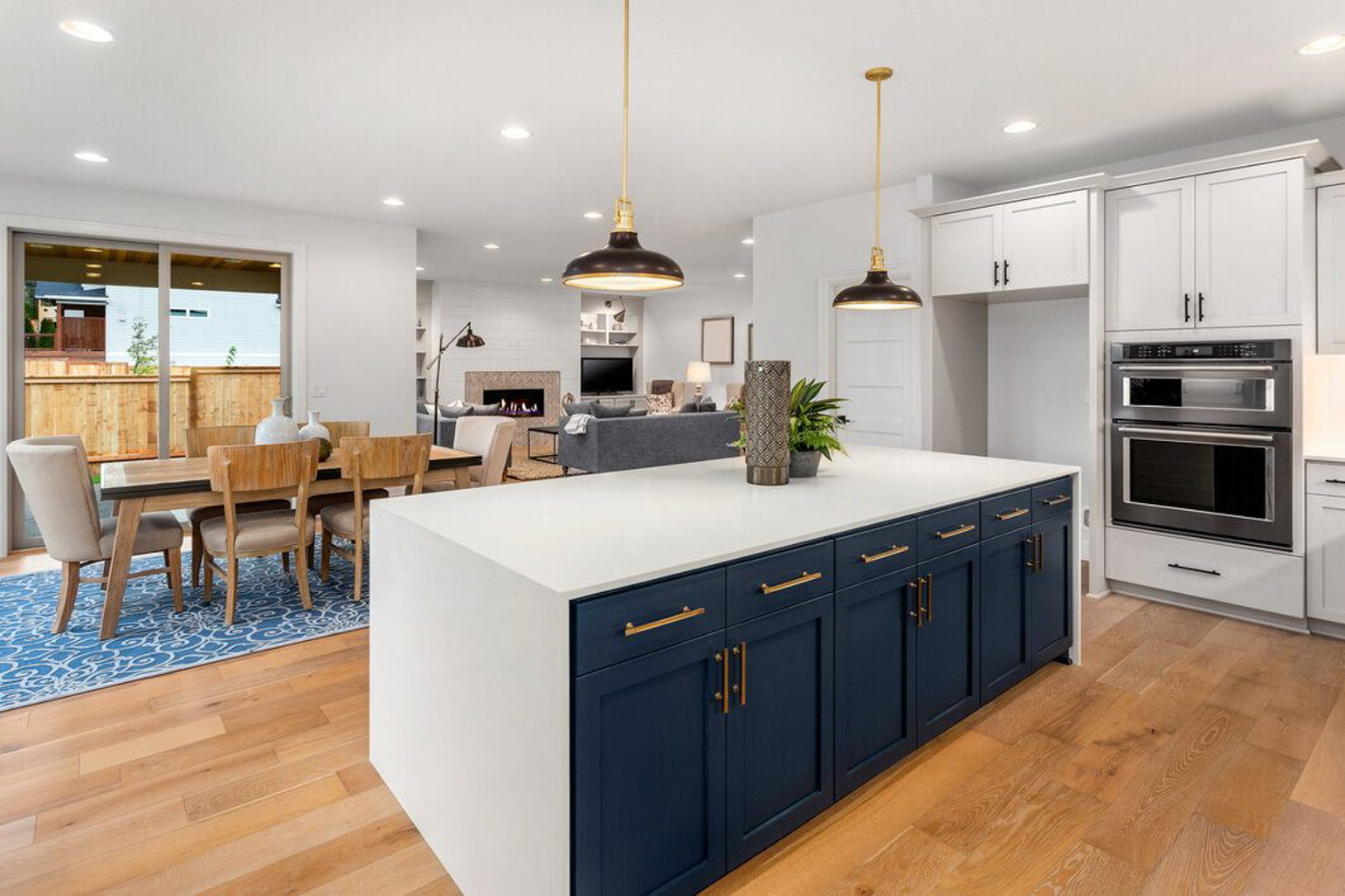 These pendants hang closer to the island surface, providing direct task lighting for cooking and prep work.
These pendants hang closer to the island surface, providing direct task lighting for cooking and prep work.
Pros: Excellent for focused light on the workspace; adds visual interest.
Cons: Can interfere with sightlines if too low; may feel crowded in small kitchens.
Best Use Case: Ideal for small to medium islands where task lighting is a priority.
17. Linear Suspension Fixture
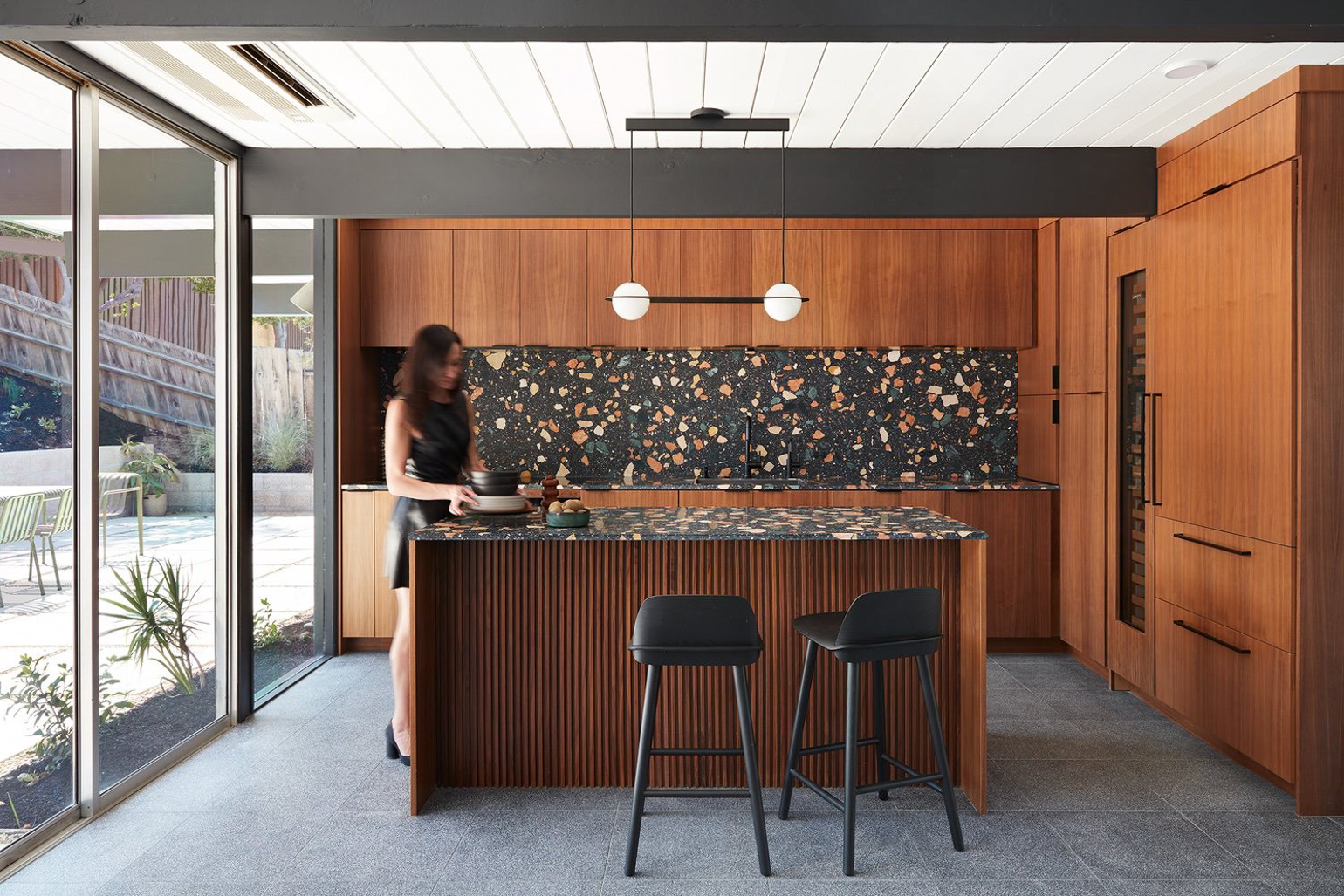 Image: Marshall Interiors
Image: Marshall Interiors
This is a single, elongated fixture that spans the length of the island for even illumination. Jennifer Bien, Director of Interior Design at DAHLIN Architecture | Planning | Interiors says, “This offers a sleek, modern look often used in high-rise condos, but is less common in traditional residential kitchens due to its minimal and somewhat commercial look.”
Pros: Provides consistent light across the entire island; clean, modern look.
Cons: Requires careful measurement to avoid overwhelming the space; installation can be tricky.
Best Use Case: Best for long or rectangular islands needing uniform lighting.
18. Mixed-Height Pendants
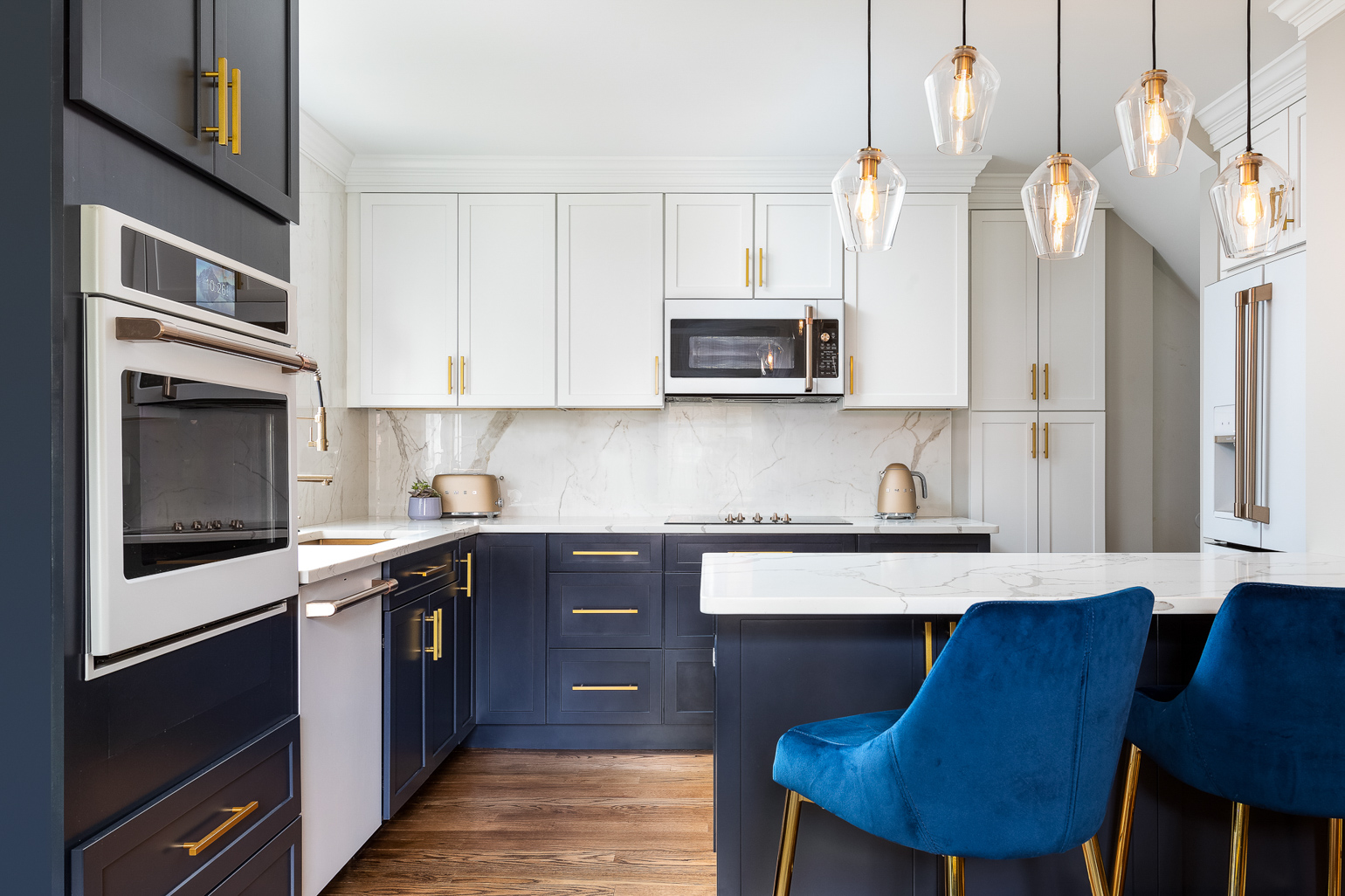 Image: AKG Design Studio
Image: AKG Design Studio
Multiple pendants are installed at different heights above the island for a dynamic look. Bien sees this style as “A playful option, well-suited to large kitchen islands with large span countertops.”
Pros: Adds depth and visual interest; can complement other kitchen layers.
Cons: Can feel busy if overdone.
Best Use Case: Works well in modern or eclectic kitchens to create a designer look.
19. Lantern-Style Pendants
.jpg) Image: Two Navy Lane
Image: Two Navy Lane
Lantern-style pendants are shaped like classic lanterns, often with glass panels and metal frames.
Pros: Adds a traditional or rustic charm; can enhance themed kitchens.
Cons: Can look out of place in ultra-modern spaces; may be heavier and require stronger mounting.
Best Use Case: Perfect for farmhouse, rustic, or vintage-style kitchens.
20. Globe Pendants
](https://assets.fixr.com/20-globe-pendants-gloribell-lebron-unnamed.jpg) Image: G. Lebron Interiors
Image: G. Lebron Interiors
Spherical lights that hang above the island, globe pendants offer a soft, even glow while adding a stylish, modern touch to the kitchen.
Pros: Soft, even light; stylish and versatile.
Cons: Can feel too delicate in large kitchens; some models are fragile.
Best Use Case: Great for contemporary, mid-century, or minimalist kitchens.
21. Large Pendants
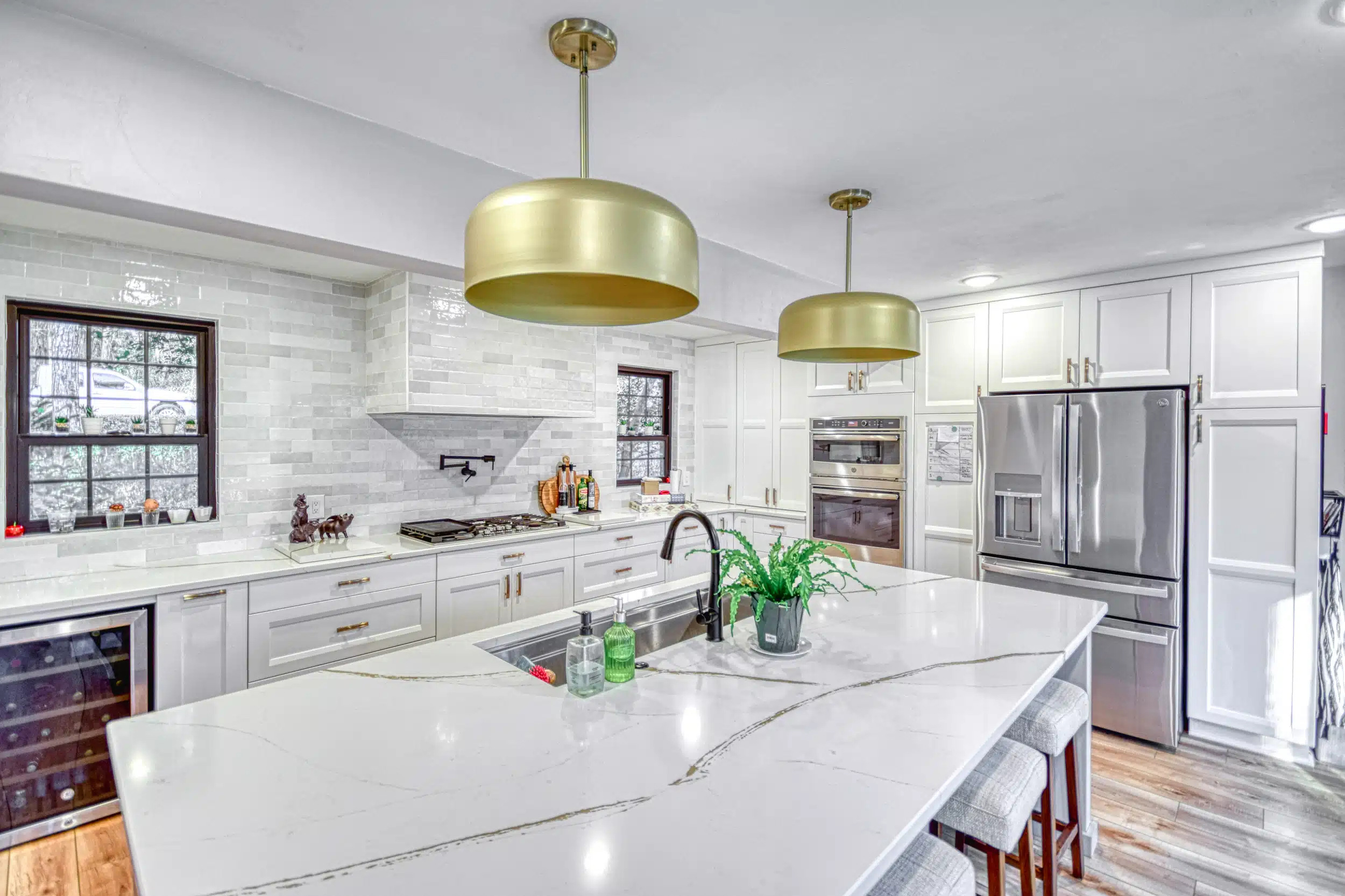 Image: McManus Kitchen and Bath
Image: McManus Kitchen and Bath
“Over kitchen islands, size and scale are key,” points out Trop. “Depending on the overall design, sometimes one oversized pendant feels right, while other spaces call for two or three smaller fixtures.”
Pros: Acts as a focal point; provides strong illumination for large islands.
Cons: Can overpower small spaces; may be expensive.
Best Use Case: Best for large islands or open-concept kitchens needing a dramatic centerpiece.
22. Double Chandeliers
.jpg) Image: Two Navy Lane
Image: Two Navy Lane
Two chandeliers instead of one can add symmetry and style.
Pros: Elegant, adds luxury and balance; provides ample lighting.
Cons: Requires high ceilings; can be expensive and complex to install.
Best Use Case: Ideal for large islands in spacious, high-ceiling kitchens.
23. Sculptural/Artistic Light Fixture
.jpg) Image: Arsight Studio
Image: Arsight Studio
These fixtures are artistic designs that double as décor and lighting. Unique lighting fixtures are cited by 33% of design experts surveyed as the top kitchen design trend this year.
Pros: Creates a strong visual statement; elevates kitchen style.
Cons: May not provide even task lighting; typically high cost.
Best Use Case: Perfect for statement kitchens or designer-focused spaces.
24. LED-Integrated Islands
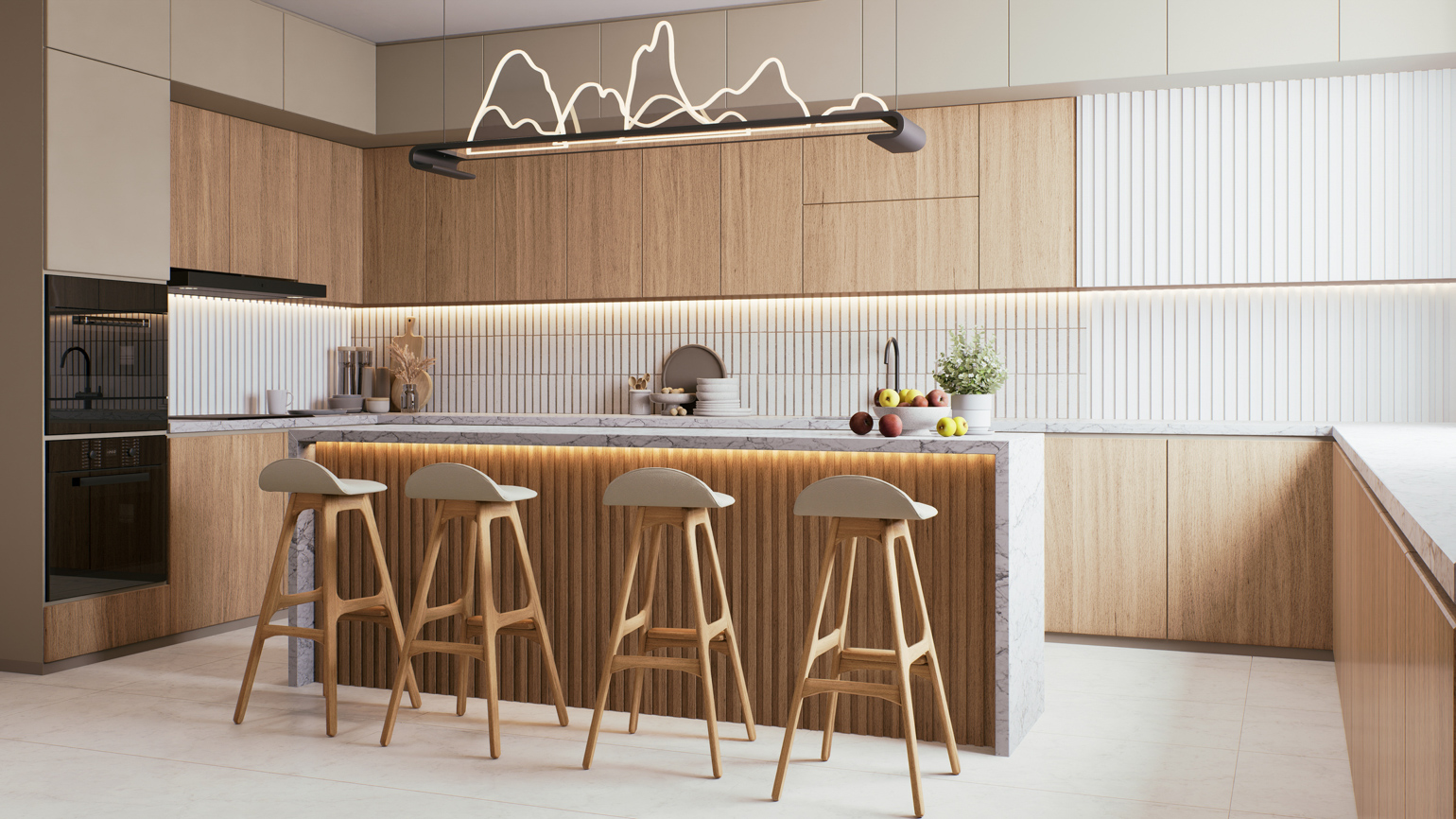 LED-integrated islands are modern fixtures with built-in LED technology, often giving a sleek and minimalistic look. According to Bien, “Many homeowners love the look of these, but they are often avoided due to high costs and challenging maintenance,” so they are not the best option for low renovation budgets.
LED-integrated islands are modern fixtures with built-in LED technology, often giving a sleek and minimalistic look. According to Bien, “Many homeowners love the look of these, but they are often avoided due to high costs and challenging maintenance,” so they are not the best option for low renovation budgets.
Pros: Energy-efficient, long-lasting, and can include dimming or color options.
Cons: Limited styles compared with traditional pendants; integrated design can be expensive to replace.
Best Use Case: Ideal for contemporary kitchens prioritizing efficiency and clean lines.
Finishes, Materials & Styles
25. Matte Black Finishes and Crisp Lines
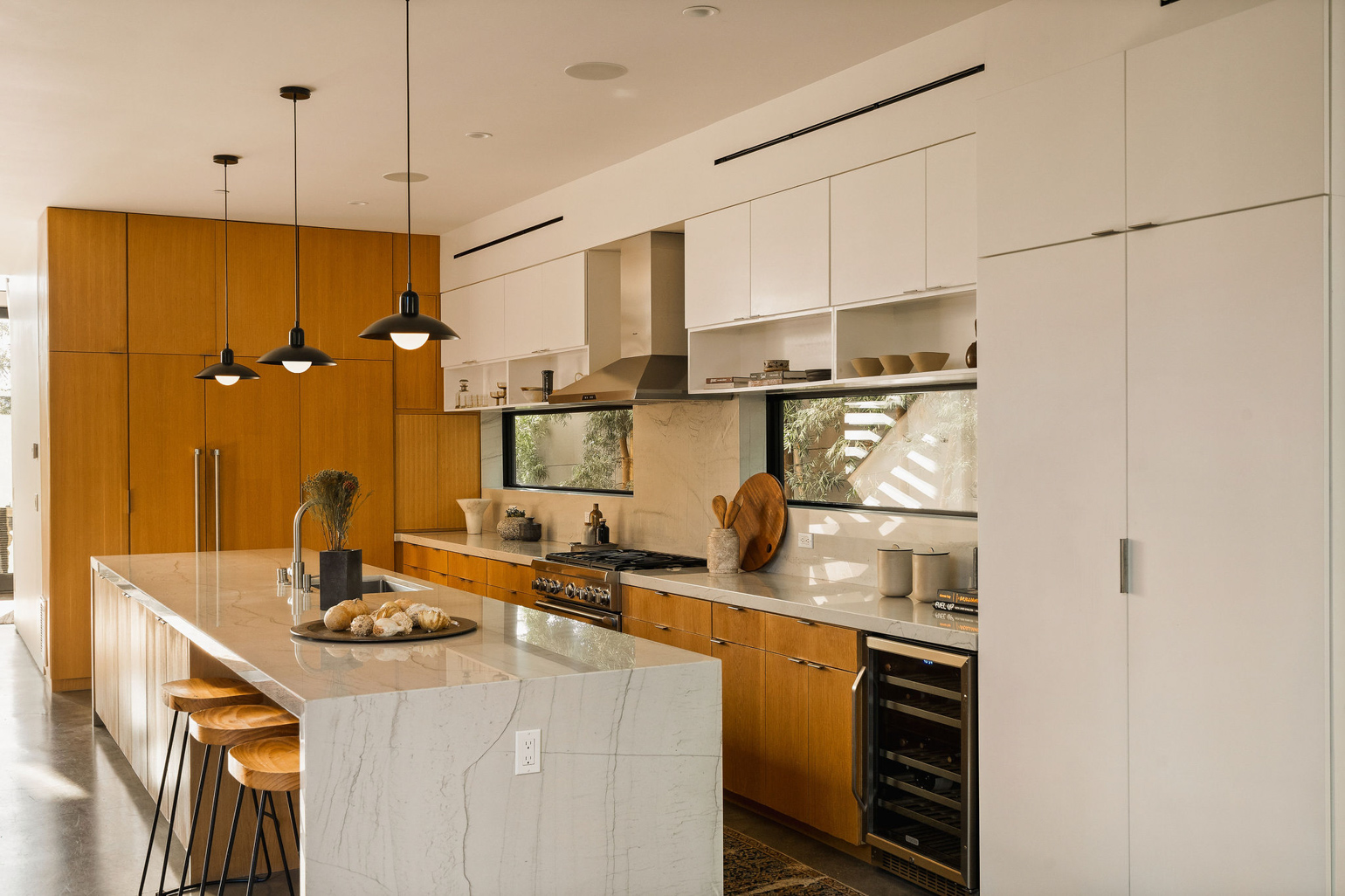 Image: Alignments Home
Image: Alignments Home
Matte black lighting fixture brings a bold, modern edge that pairs well with both contemporary and transitional kitchens. The dark finish grounds the space and highlights surrounding materials, especially lighter tones. “Matte black finishes and crisp lines create contrast with the white cabinets,” adds Niemela.
Pros: Timeless, versatile, hides fingerprints and dust.
Cons: Can feel stark or heavy in small, dimly lit spaces.
Best Use Case: Perfect for modern or industrial kitchens needing a strong contrast.
26. Brass Finishes
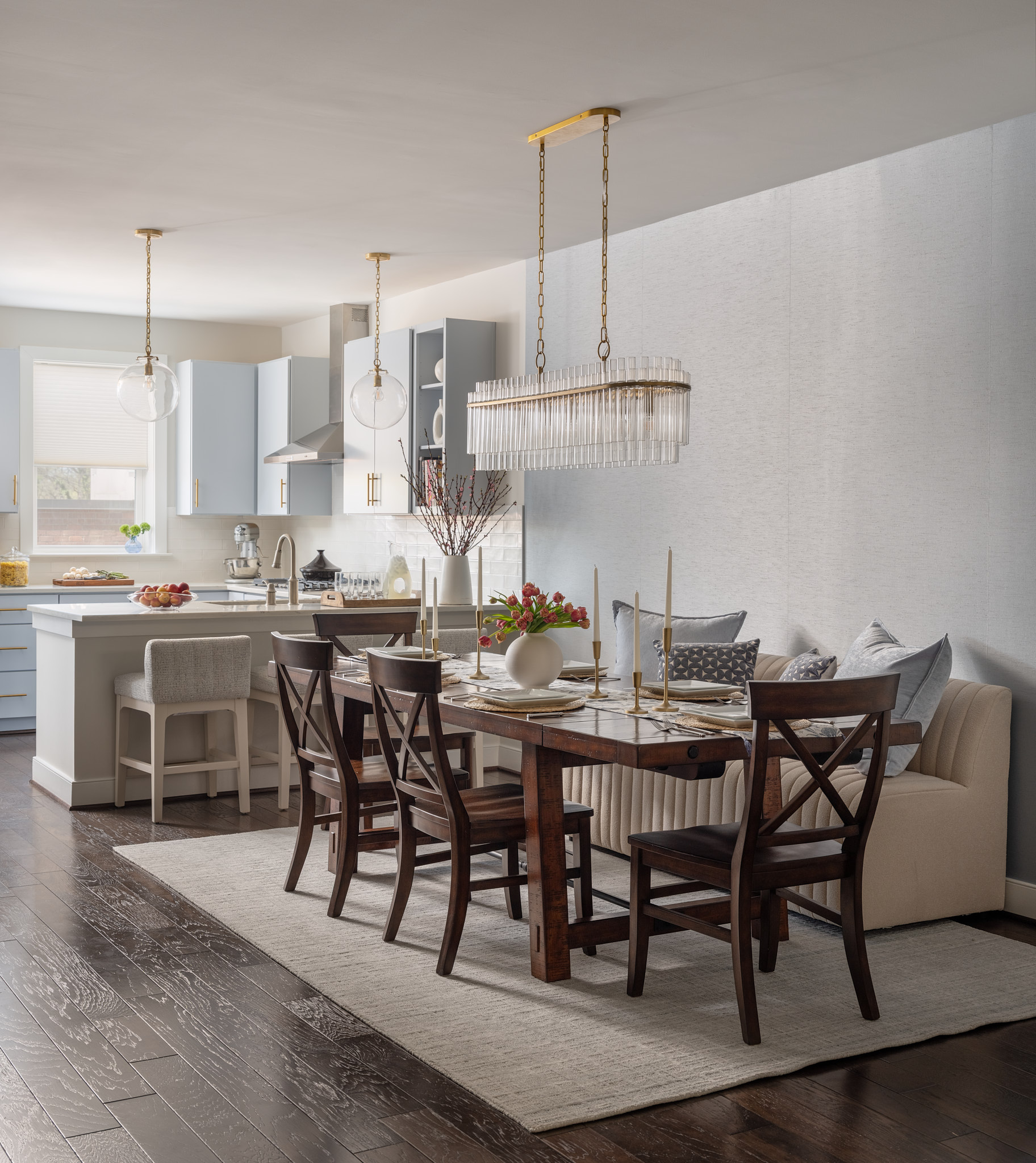 Image: Two Navy Lane
Image: Two Navy Lane
Brass lighting is one of the standout kitchen trends this year. Finishes range from polished and shiny to brushed, satin, or antique, and its golden tones pair beautifully with wood, marble, or darker cabinetry.
Pros: Warm and elegant, versatile across styles, and ages gracefully with patina.
Cons: Can tarnish over time if not sealed; generally pricier than standard finishes.
Best Use Case: Ideal for kitchens aiming to capture a timeless yet on-trend look with a touch of luxury.
27. Mixed-Metal Fixtures
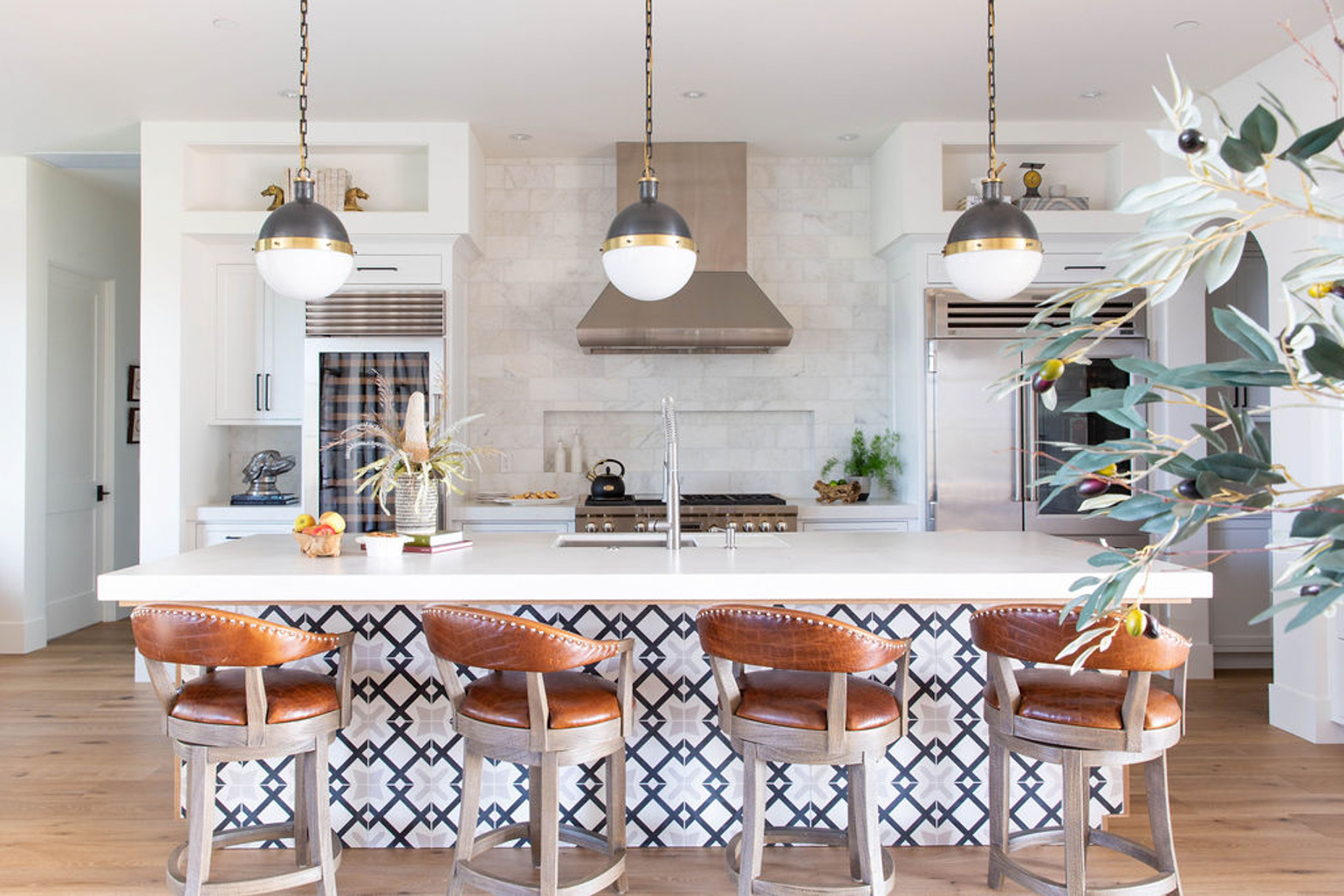 Image: Kerrie Kelly Design Lab
Image: Kerrie Kelly Design Lab
“Combining chrome, stainless, or brass with black finishes is now common. While matching all metals was once standard, this can be limiting on style and cost,” shares Bien.
Pros: Adds personality and design flexibility.
Cons: If not balanced, can look mismatched or busy.
Best Use Case: Ideal for transitional or eclectic kitchens blending multiple finishes.
28. Bamboo Pendants
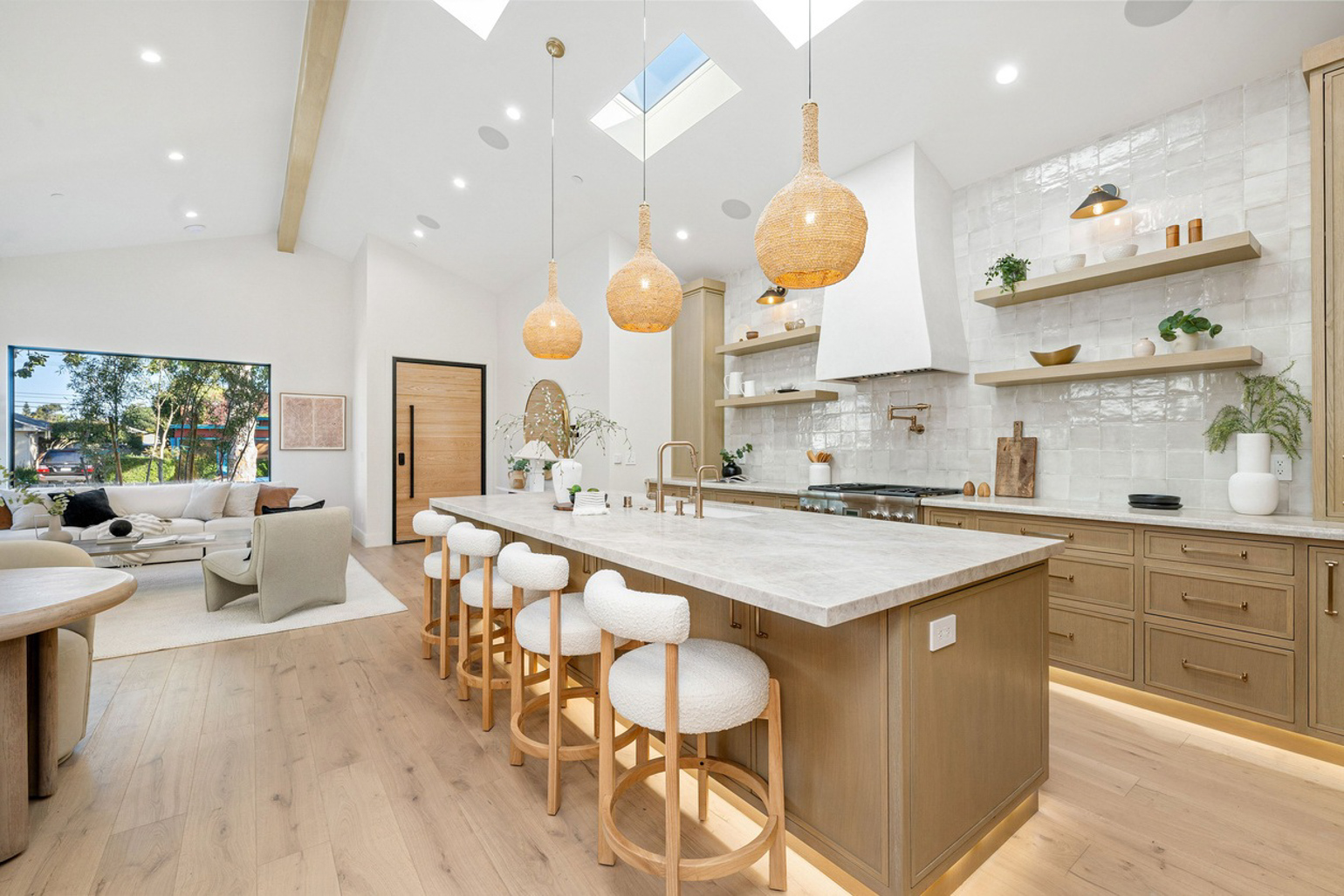 Natural bamboo shades introduce warmth and texture with a relaxed, organic feel.
Natural bamboo shades introduce warmth and texture with a relaxed, organic feel.
Pros: Eco-friendly, lightweight, and creates soft, diffused light.
Cons: Less durable over time; not suited for very formal kitchens.
Best Use Case: Great for coastal, bohemian, or nature-inspired kitchens.
29. Crystal Chandeliers
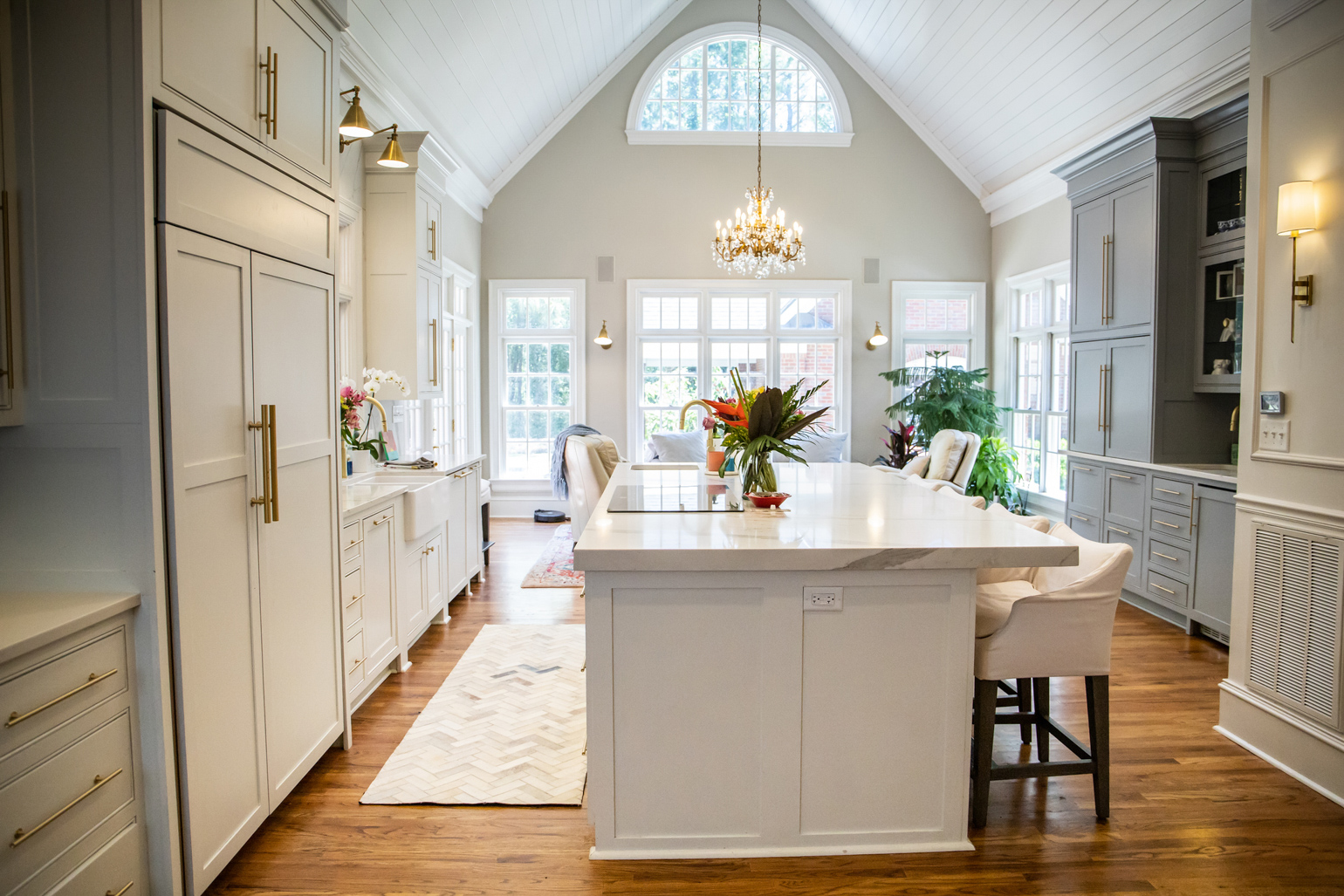 Crystal chandeliers bring a touch of glamour and elegance, making them a striking focal point in any kitchen.
Crystal chandeliers bring a touch of glamour and elegance, making them a striking focal point in any kitchen.
Pros: Adds luxury and sophistication; excellent light refraction.
Cons: Requires frequent cleaning; can feel over-the-top in casual spaces; It has a high price.
Best Use Case: Best for high-end or formal kitchens where drama and elegance are desired.
30. Rustic Kitchen Lighting - Wooden Light Fixtures
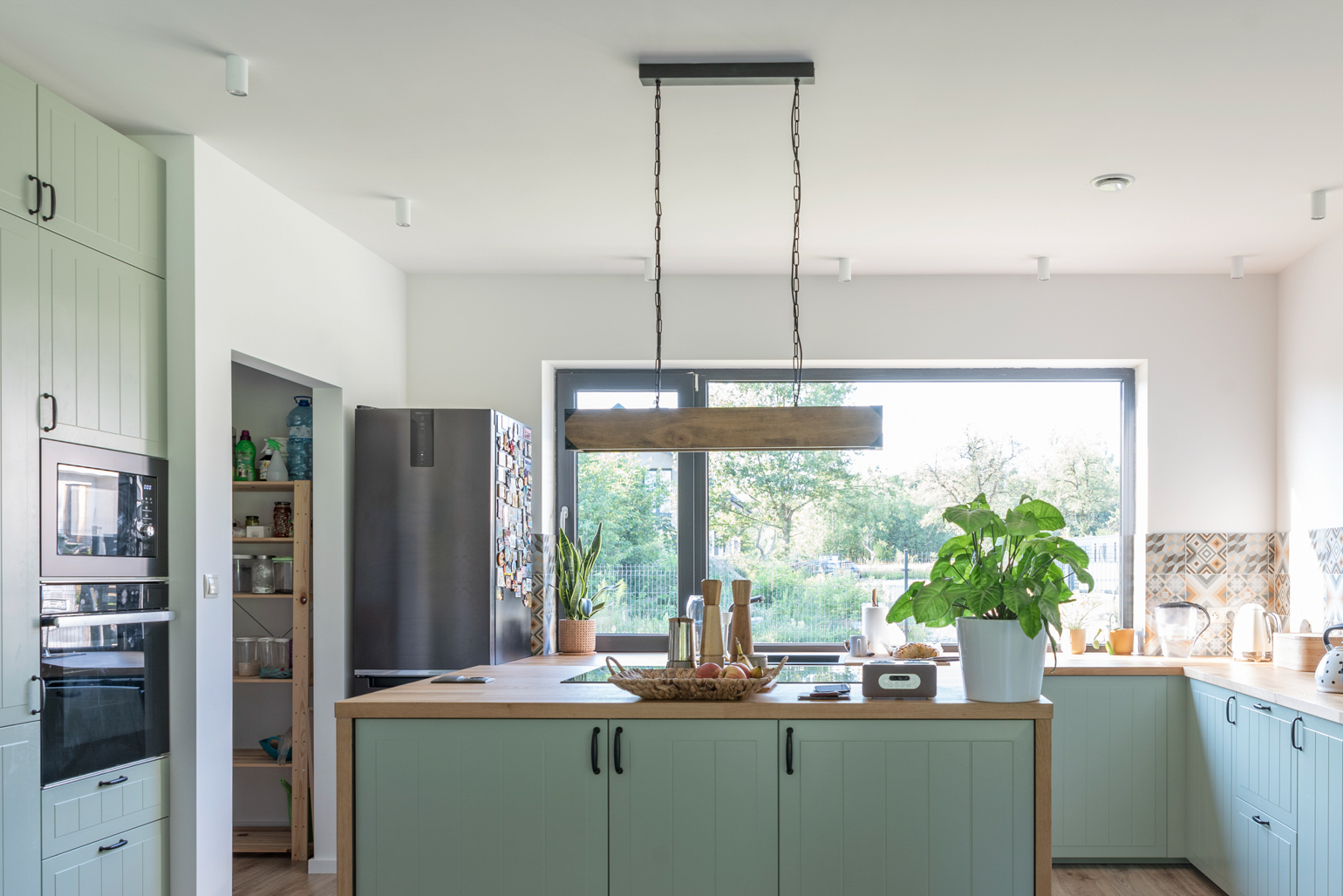 Wood-based fixtures highlight natural materials and create a cozy, farmhouse-inspired vibe.
Wood-based fixtures highlight natural materials and create a cozy, farmhouse-inspired vibe.
Pros: Warm, inviting, and versatile across rustic or country styles.
Cons: Susceptible to moisture damage if not treated; can feel heavy in small kitchens.
Best Use Case: Perfect for farmhouse, rustic, or country kitchens.
31. Vintage Kitchen Lighting
-1758115854.jpg) Image: Two Navy Lane
Image: Two Navy Lane
Vintage-inspired fixtures often feature aged finishes, Edison bulbs, or antique silhouettes. They bring nostalgic charm to the kitchen.
Pros: Adds character and uniqueness; pairs well with retro appliances.
Cons: May not provide as much brightness as modern options.
Best Use Case: Best for retro, eclectic, or historically styled kitchens.
32. Minimalist Lighting
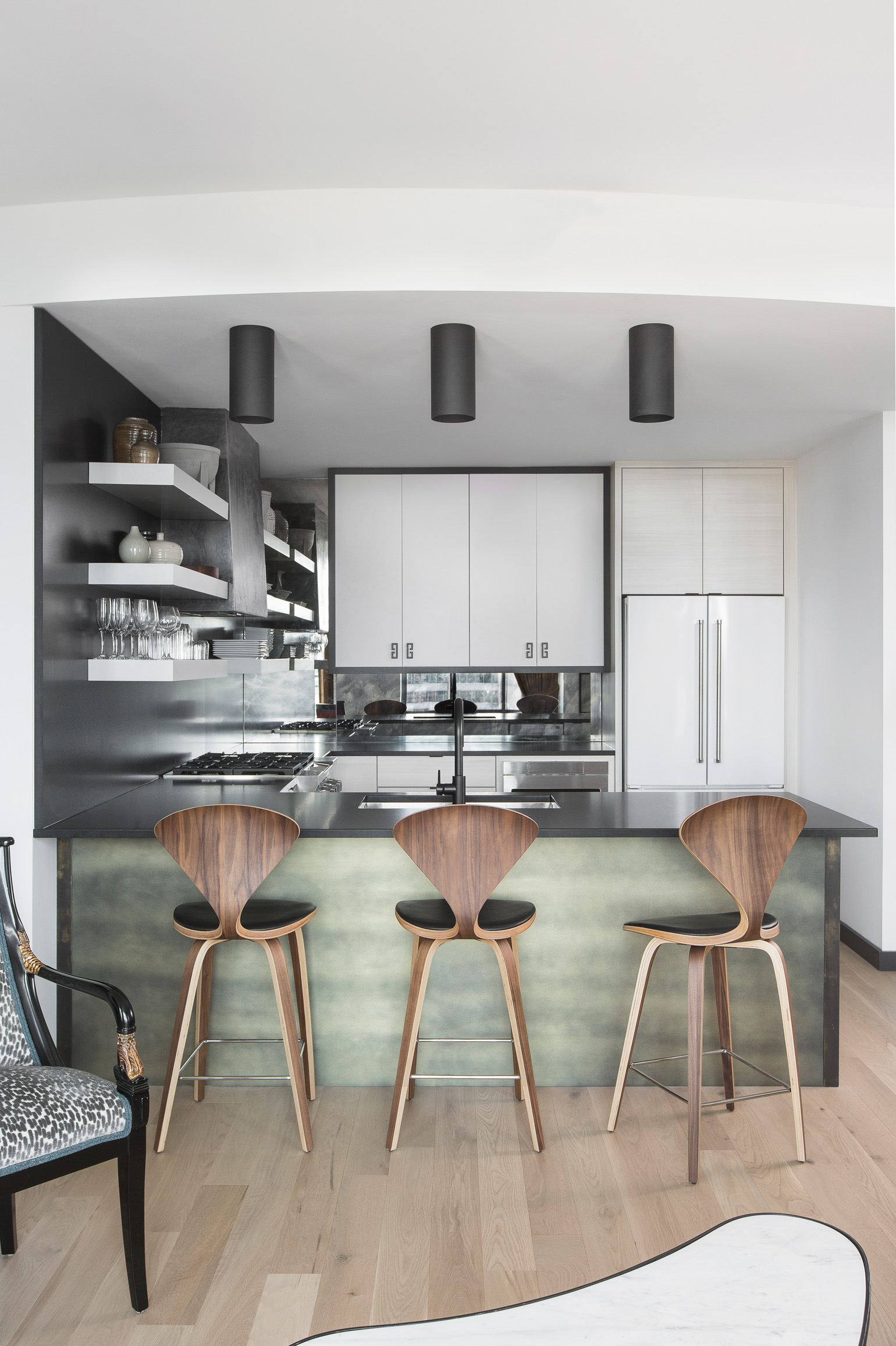 Image: Jacob Laws Interior Design
Image: Jacob Laws Interior Design
Streamlined designs with simple shapes and neutral finishes keep the focus on function and clean aesthetics.
Pros: Works with almost any style, budget-friendly, and never feels cluttered.
Cons: May lack the “wow” factor or personality of bolder fixtures.
Best Use Case: Perfect for modern, Scandinavian, or small kitchens where simplicity is key.
33. Mid-Century Inspired Chandelier
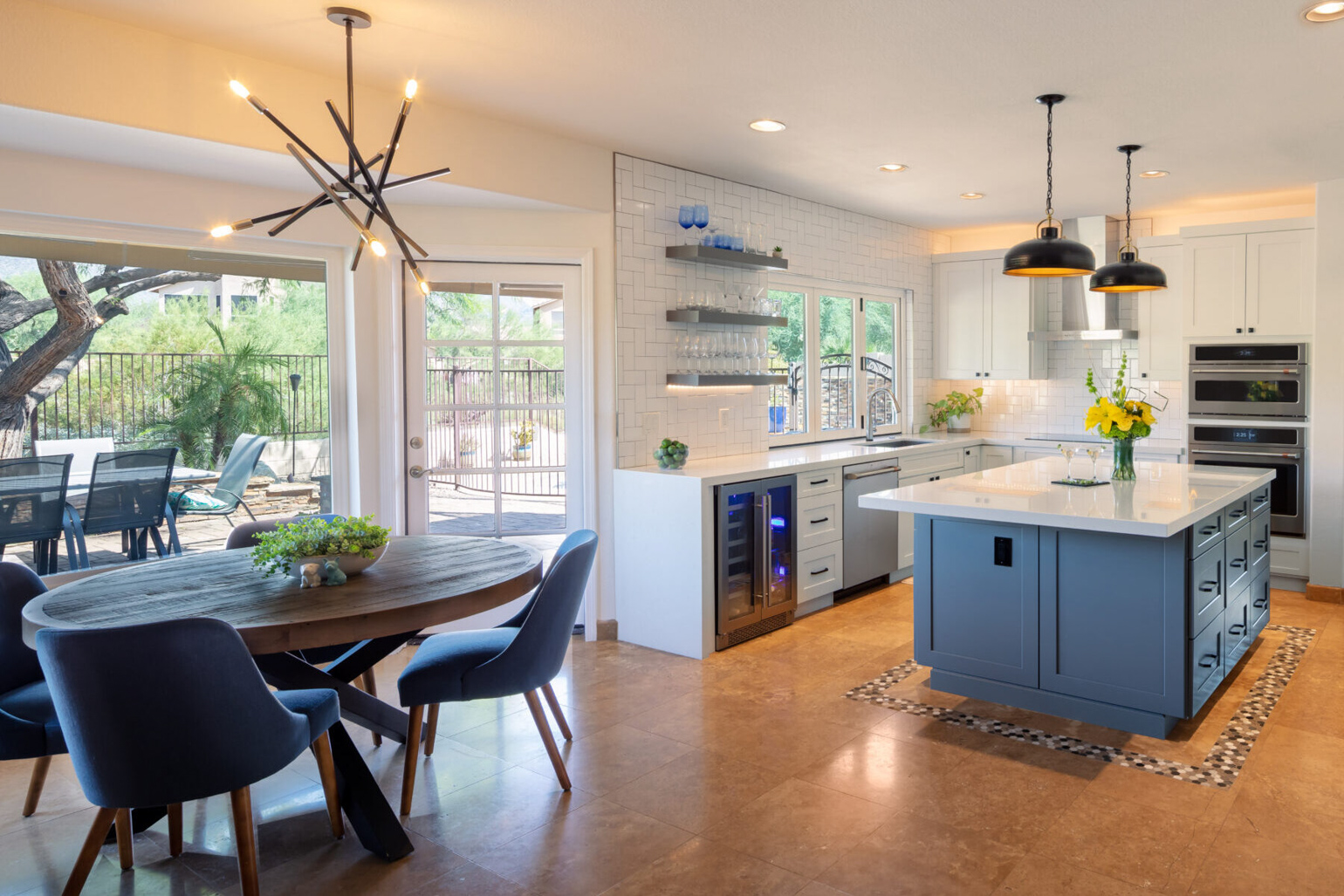 Image: ArDan Construction
Image: ArDan Construction
Niemela recommends a mid-century inspired Sputnik chandelier above the dining nook. “This sculptural light casts a warm glow and emits light in all directions to help reduce shadows and provide ambient light.”
Pros: Stylish focal point; works well in both vintage and modern kitchens.
Cons: Can feel too bold in small spaces; limited compatibility with very traditional designs.
Best Use Case: Perfect for open-concept kitchens or dining-kitchen combos.
34. Uplighting
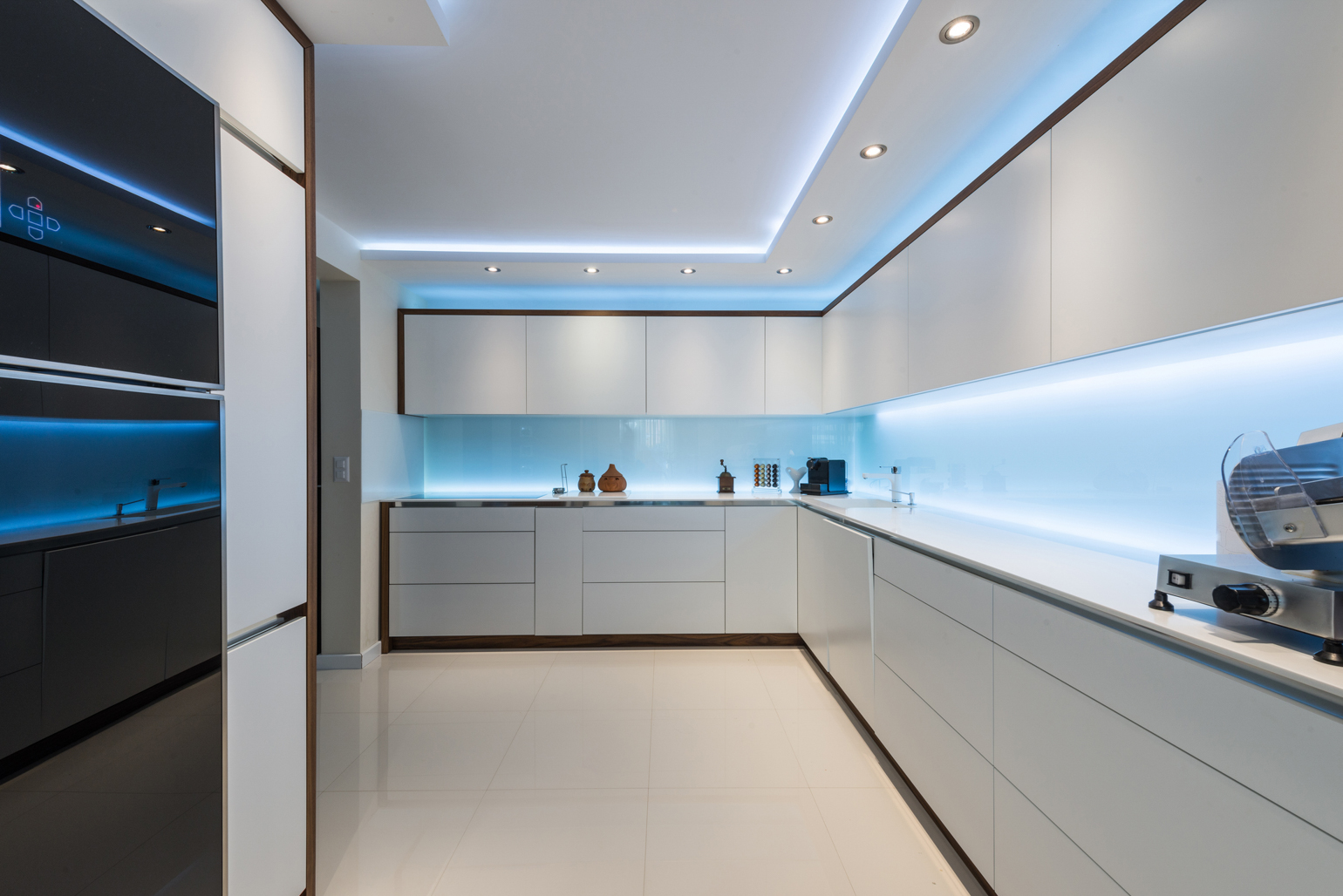 Uplights direct illumination upward toward the ceiling, creating a soft, ambient glow that reduces shadows.
Uplights direct illumination upward toward the ceiling, creating a soft, ambient glow that reduces shadows.
Pros: Expands the sense of space; adds mood lighting without harshness.
Cons: Doesn’t provide strong task lighting; requires additional fixtures for full coverage.
Best Use Case: Best for kitchens where ambiance and layered lighting are priorities.
35. Layer Lighting
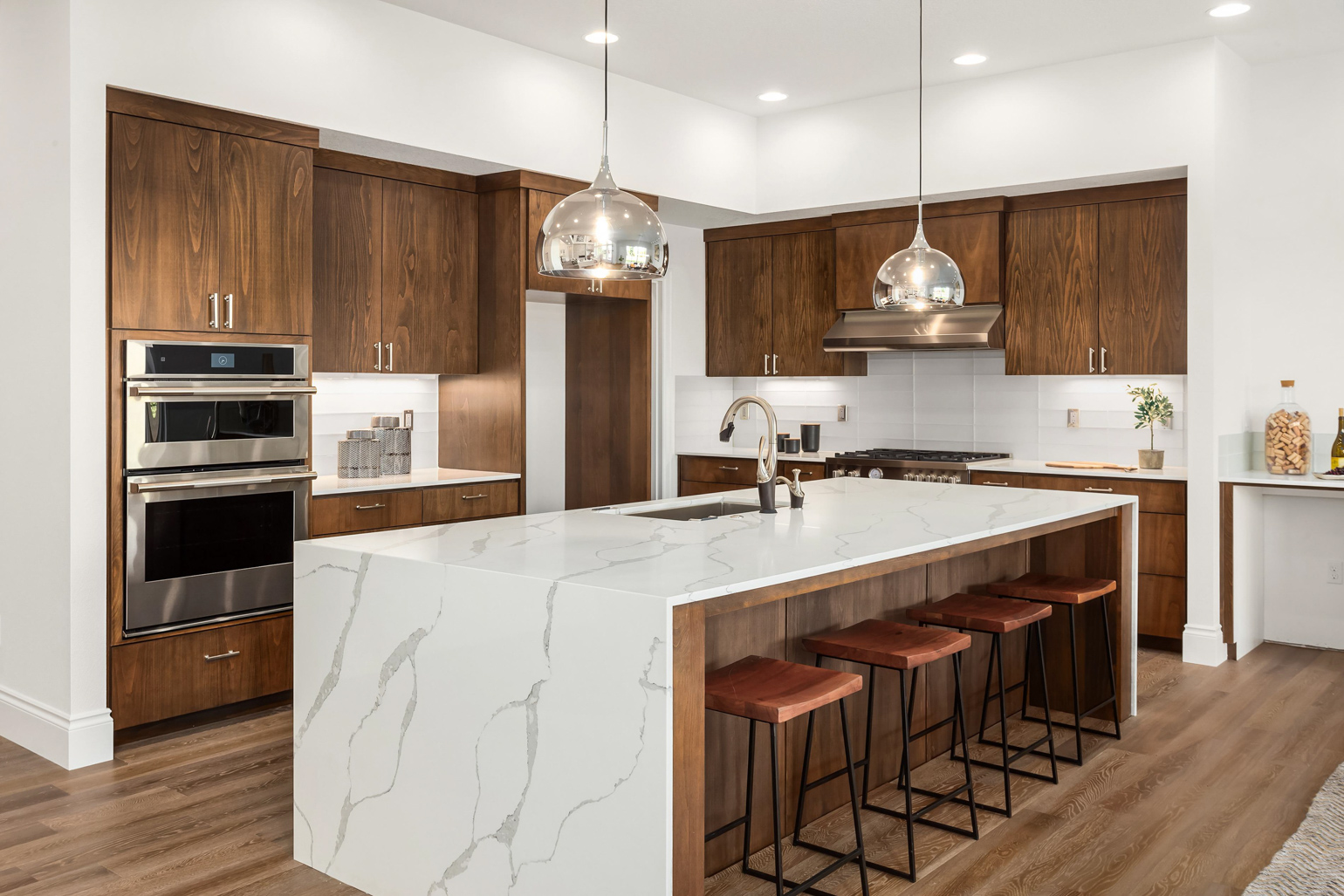 Layering combines ambient, task, and accent lighting to achieve balance and flexibility. It’s also one of the biggest kitchen trends for 2025, according to design experts.
Layering combines ambient, task, and accent lighting to achieve balance and flexibility. It’s also one of the biggest kitchen trends for 2025, according to design experts.
Pros: Adapts to different needs and moods; creates depth and sophistication.
Cons: Requires careful planning and often higher upfront costs.
Best Use Case: Ideal for kitchens that serve multiple functions.
36. Mismatching Fixtures
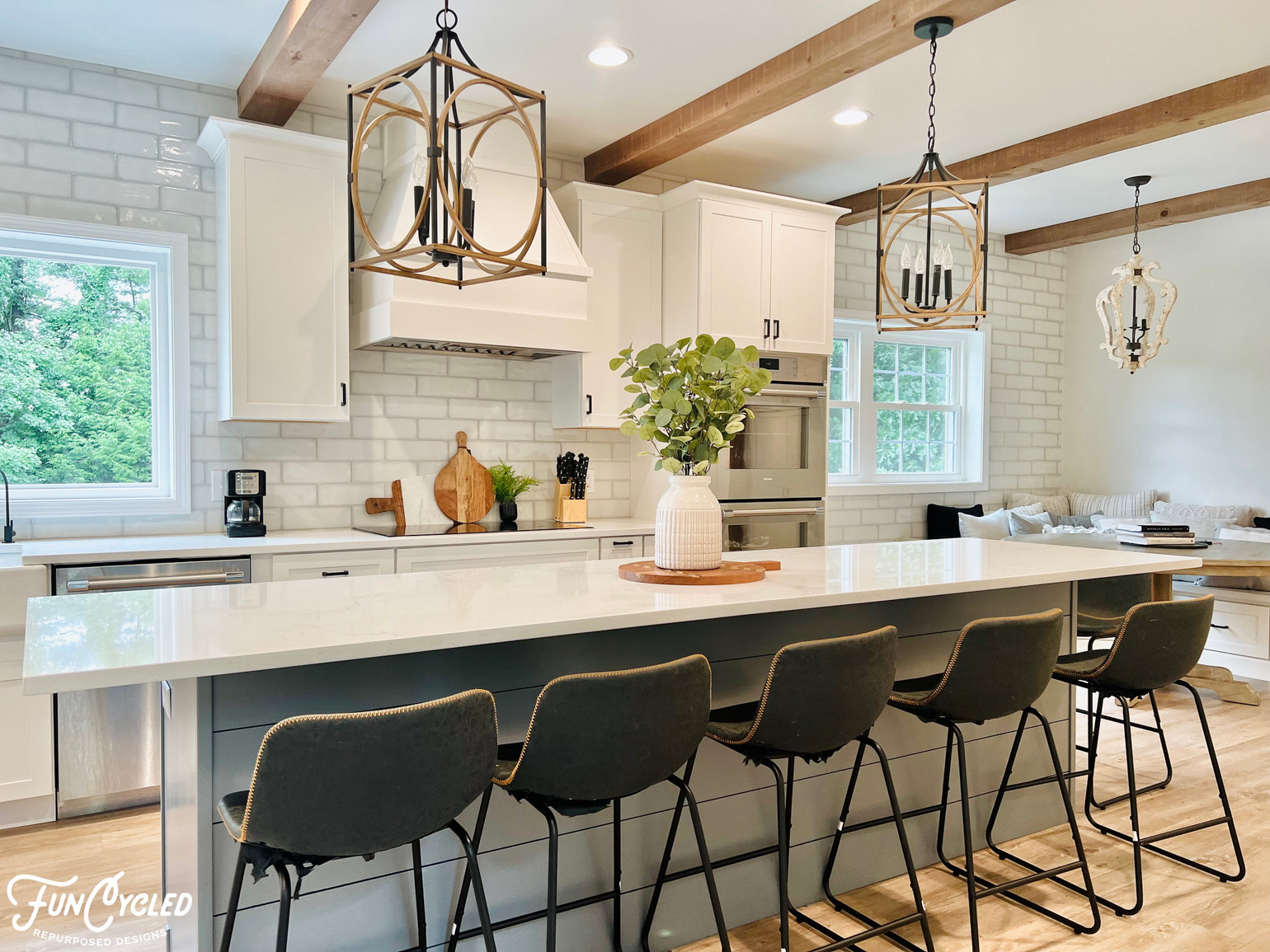 Image: FunCycled
Image: FunCycled
Intentionally combining different fixture styles, shapes, or finishes creates a collected, eclectic look. “Fixtures don’t need to match, but they should coordinate. Selecting complementary styles helps maintain cohesion, while variation between fixtures subtly defines different zones,“ says Trop
Pros: Adds personality and uniqueness; allows creativity and flexibility.
Cons: Easy to overdo, leading to visual clutter or disharmony.
Best Use Case: Works in eclectic or transitional kitchens where individuality is a design goal.
Smart Kitchen Lighting
Smart Fixtures, Bulbs, and Systems – These are increasingly popular for convenience and functionality. Having the ability to remotely control your fixtures from virtually anywhere and change the tones for different tasks can be helpful.
- Jennifer Bien, Director of Interior Design, DAHLIN Architecture | Planning | Interiors
37. Color-Changing RGB LEDs
Color-changing LEDs let you switch between millions of colors, perfect for setting mood or adding personality.
Pros: Highly customizable ambiance; fun for entertaining or themed decor.
Cons: Can feel gimmicky if overused; may not provide consistent task lighting.
Best Use Case: Great for open kitchens or entertaining spaces where mood lighting is key.
38. Tunable White LEDs (Warm vs. Cool)
Adjustable white LEDs allow you to change the warmth or coolness of your light throughout the day.
Pros: Supports different activities; improves visual comfort and atmosphere.
Cons: Requires smart controls; slightly higher upfront cost.
Best Use Case: Ideal for kitchens that serve multiple functions, from cooking to dining.
39. Motion-Sensor Under-Cabinet Lights
Lights turn on automatically when you approach counters, offering hands-free convenience.
Pros: Energy-efficient; reduces fumbling in the dark; adds modern convenience.
Cons: Sensors can trigger accidentally; may require occasional maintenance.
Best Use Case: Perfect for busy prep areas or small kitchens with limited overhead lighting.
40. Smart LED Strip Uplighting (Above Cabinets)
Soft, customizable glow highlights cabinet tops or architectural features.
Pros: Adds depth and drama; accentuates kitchen design elements.
Cons: Can highlight dust or imperfections; may need professional installation.
Best Use Case: Works well in kitchens with crown molding or elevated cabinets for decorative effect.
41. Smart Toe-Kick Lighting
Subtle floor-level lights create a modern floating effect and gently illuminate the base of islands or cabinets.
Pros: Low-level night lighting; stylish modern accent; energy-efficient.
Cons: Limited task use; may require careful placement to avoid glare.
Best Use Case: Ideal for large islands or kitchens used at night without overhead lights.
42. Smart Track Lighting
Adjustable tracks direct light exactly where it’s needed, with app or voice control.
Pros: Flexible and versatile; supports task and accent lighting; modern look.
Cons: Can dominate ceiling space; may be pricey.
Best Use Case: Great for kitchens with multiple work zones or islands requiring adjustable task lighting.
FAQ: Kitchen Lighting
Unique fixtures, layered lighting, and warm brass finishes are among the biggest 2025 trends, combining style with functionality.
A mix of task, ambient, and accent lighting is best for kitchens, providing the right illumination for cooking, meal prep, and dining while creating a warm and inviting atmosphere.
Overly ornate, heavy fixtures and harsh fluorescent lights are fading out in favor of clean lines and energy-efficient LEDs.
Kitchen islands in 2025 are trending with statement pendants, mixed-height fixtures, and sculptural designs that act as both functional lighting and eye-catching centerpiece elements.
Laura Madrigal is the Home Design Specialist at Fixr.com, dedicated to identifying and analyzing significant changes within residential design. She is the author of leading trends reports on interior design, kitchen, and bathroom, and her insights have been featured in publications like Realtor and the New York Post.
